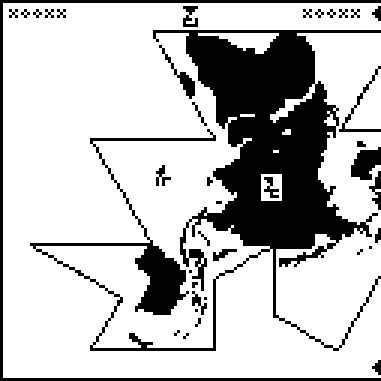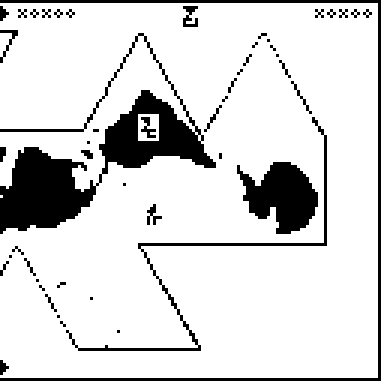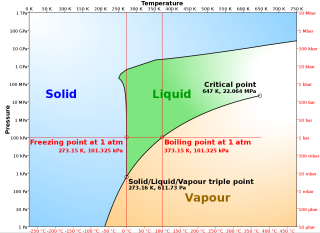Mark Dominus (陶敏修)
mjd@pobox.com

Archive:
| 2025: | JFMAM |
| 2024: | JFMAMJ |
| JASOND | |
| 2023: | JFMAMJ |
| JASOND | |
| 2022: | JFMAMJ |
| JASOND | |
| 2021: | JFMAMJ |
| JASOND | |
| 2020: | JFMAMJ |
| JASOND | |
| 2019: | JFMAMJ |
| JASOND | |
| 2018: | JFMAMJ |
| JASOND | |
| 2017: | JFMAMJ |
| JASOND | |
| 2016: | JFMAMJ |
| JASOND | |
| 2015: | JFMAMJ |
| JASOND | |
| 2014: | JFMAMJ |
| JASOND | |
| 2013: | JFMAMJ |
| JASOND | |
| 2012: | JFMAMJ |
| JASOND | |
| 2011: | JFMAMJ |
| JASOND | |
| 2010: | JFMAMJ |
| JASOND | |
| 2009: | JFMAMJ |
| JASOND | |
| 2008: | JFMAMJ |
| JASOND | |
| 2007: | JFMAMJ |
| JASOND | |
| 2006: | JFMAMJ |
| JASOND | |
| 2005: | OND |
In this section:
Subtopics:
| Mathematics | 245 |
| Programming | 99 |
| Language | 95 |
| Miscellaneous | 75 |
| Book | 50 |
| Tech | 49 |
| Etymology | 35 |
| Haskell | 33 |
| Oops | 30 |
| Unix | 27 |
| Cosmic Call | 25 |
| Math SE | 25 |
| Law | 22 |
| Physics | 21 |
| Perl | 17 |
| Biology | 15 |
| Brain | 15 |
| Calendar | 15 |
| Food | 15 |
Comments disabled
Mon, 21 Dec 2015
A message to the aliens, part 23/23 (wat)
Earlier articles: Introduction Common features Page 1 (numerals) Page 2 (arithmetic) Page 3 (exponents) Page 4 (algebra) Page 5 (geometry) Page 6 (chemistry) Page 7 (mass) Page 8 (time and space) Page 9 (physical units) Page 10 (temperature) Page 11 (solar system) Page 12 (Earth-Moon system) Page 13 (days, months, and years) Page 14 (terrain) Page 15 (human anatomy) Page 16 (vital statistics) Page 17 (DNA chemistry) Page 18 (cell respiration and division) Pages 19-20 (map of the Earth) Page 21 (the message) Page 22 (cosmology)
This is page 23 (the last) of the Cosmic Call message. An explanation follows.

This page is a series of questions for the recipients of the message.
It is labeled with the glyph  , which heretofore
appeared only on page 4 in the context
of solving of algebraic equations. So we might interpret it as
meaning a solution or a desire to solve or understand. I have chosen to translate
it as “wat”.
, which heretofore
appeared only on page 4 in the context
of solving of algebraic equations. So we might interpret it as
meaning a solution or a desire to solve or understand. I have chosen to translate
it as “wat”.
I find this page irritating in its vagueness and confusion. Its
layout is disorganized. Glyphs are used inconsistent with their uses
elsewhere on the page and elsewhere in the message.
For example, the mysterious glyph
 , which
has something to do with the recipients of the message, and which
appeared only on page 21 is used here to
ask about both the recipients themselves and also about their planet.
, which
has something to do with the recipients of the message, and which
appeared only on page 21 is used here to
ask about both the recipients themselves and also about their planet.
The questions are arranged in groups. For easy identification, I have color-coded the groups.
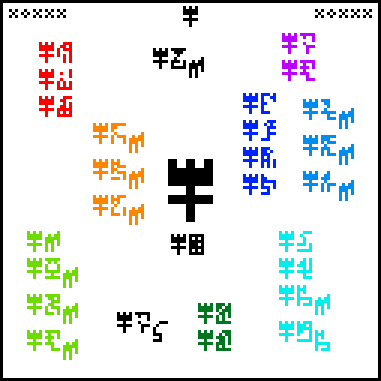
Starting from the upper-left corner, and proceeding counterclockwise, we have:
 Kilograms, meters, and seconds, wat. I would have used the glyphs for
abstract mass, distance, and time,
Kilograms, meters, and seconds, wat. I would have used the glyphs for
abstract mass, distance, and time,

 and
and  ,
since that seems to be closer to the intended meaning.
,
since that seems to be closer to the intended meaning.
 Alien mathematics, physics, and biology, wat. Note that this asks
specifically about the recipients’ version of the sciences.
None of these three glyphs has been subscripted before. Will the
meaning be clear to the recipients? One also wonders why the message
doesn't express a desire to understand human science, or science
generally. One might argue that it does not make sense to ask the
recipients about the human versions of mathematics and physics. But a
later group expresses a desire to understand males and females, and the
recipients don't know anything about that either.
Alien mathematics, physics, and biology, wat. Note that this asks
specifically about the recipients’ version of the sciences.
None of these three glyphs has been subscripted before. Will the
meaning be clear to the recipients? One also wonders why the message
doesn't express a desire to understand human science, or science
generally. One might argue that it does not make sense to ask the
recipients about the human versions of mathematics and physics. But a
later group expresses a desire to understand males and females, and the
recipients don't know anything about that either.
 Aliens wat. Alien [planet] mass, radius, acceleration wat.
The meaning of
Aliens wat. Alien [planet] mass, radius, acceleration wat.
The meaning of
 shifts here from meaning the recipients themselves to the recipients’
planet. “Acceleration”
shifts here from meaning the recipients themselves to the recipients’
planet. “Acceleration”
 is intended to refer to the planet's gravitational acceleration as
on page 14. What if the recipients
don't live on a planet? I suppose they will be familiar with planets
generally and with the fact that we live on a planet, which explained
back on pages 11–13, and will get the idea.
is intended to refer to the planet's gravitational acceleration as
on page 14. What if the recipients
don't live on a planet? I suppose they will be familiar with planets
generally and with the fact that we live on a planet, which explained
back on pages 11–13, and will get the idea.
 Fucking speed of light, how does it work?
Fucking speed of light, how does it work?
 Planck's constant, wat. Universal gravitation constant, wat?
Planck's constant, wat. Universal gravitation constant, wat?
 Males and females, wat. Alien people, wat. Age of people,
wat. This group seems to be about our desire to understand ourselves,
except that the third item relates to the aliens. I'm not quite sure
what is going on. Perhaps “males and females” is intended to refer to
the recipients? But the glyphs are not subscripted, and there is no
strong reason to believe that the aliens have the same sexuality.
Males and females, wat. Alien people, wat. Age of people,
wat. This group seems to be about our desire to understand ourselves,
except that the third item relates to the aliens. I'm not quite sure
what is going on. Perhaps “males and females” is intended to refer to
the recipients? But the glyphs are not subscripted, and there is no
strong reason to believe that the aliens have the same sexuality.
The glyph
 , already used
both to mean the age of the Earth and the typical human lifespan, is
even less clear here. Does it mean we want to understand the reasons
for human life expectancy? Or is it intended to continue the inquiry
from the previous line and is asking about the recipients’ history or
lifespan?
, already used
both to mean the age of the Earth and the typical human lifespan, is
even less clear here. Does it mean we want to understand the reasons
for human life expectancy? Or is it intended to continue the inquiry
from the previous line and is asking about the recipients’ history or
lifespan?
 Land, water, and atmosphere of the recipients’ planet, wat.
Land, water, and atmosphere of the recipients’ planet, wat.
 Energy, force, pressure, power, wat. The usage here is
inconsistent from the first group, which asked not about mass,
distance, and time but about kilograms, meters, and seconds specifically.
Energy, force, pressure, power, wat. The usage here is
inconsistent from the first group, which asked not about mass,
distance, and time but about kilograms, meters, and seconds specifically.
 Velocity and acceleration, wat. I wonder why these are in a
separate group, instead of being clustered with the previous group or
the first group. I also worry about the equivocation in
Velocity and acceleration, wat. I wonder why these are in a
separate group, instead of being clustered with the previous group or
the first group. I also worry about the equivocation in
 acceleration,
which is sometimes used to mean the Earth's gravitational acceleration
and sometimes acceleration generally. We already said we want to
understand
mass
acceleration,
which is sometimes used to mean the Earth's gravitational acceleration
and sometimes acceleration generally. We already said we want to
understand
mass  ,
!!G!!
,
!!G!!  ,
and the size of the Earth. The Earth's surface gravity can be
straightforwardly calculated from these, so there's nothing else to
understand about that.
,
and the size of the Earth. The Earth's surface gravity can be
straightforwardly calculated from these, so there's nothing else to
understand about that.
 Alien planet, wat.
The glyph
Alien planet, wat.
The glyph
 has
heretofore been used only to refer to the planet Earth. It does not mean planets
generally, because it was not used in connection with Jupiter
has
heretofore been used only to refer to the planet Earth. It does not mean planets
generally, because it was not used in connection with Jupiter
 .
Here, however, it
seems to refer to the recipients’ planet.
.
Here, however, it
seems to refer to the recipients’ planet.
 The universe, wat. HUH???
The universe, wat. HUH???
That was the last page. Thanks for your kind attention.
[ Many thanks to Anna Gundlach, without whose timely email I might not have found the motivation to finish this series. ]
[Other articles in category /aliens/dd] permanent link
Sat, 12 Dec 2015
A message to the aliens, part 22/23 (cosmology)
Earlier articles: Introduction Common features Page 1 (numerals) Page 2 (arithmetic) Page 3 (exponents) Page 4 (algebra) Page 5 (geometry) Page 6 (chemistry) Page 7 (mass) Page 8 (time and space) Page 9 (physical units) Page 10 (temperature) Page 11 (solar system) Page 12 (Earth-Moon system) Page 13 (days, months, and years) Page 14 (terrain) Page 15 (human anatomy) Page 16 (vital statistics) Page 17 (DNA chemistry) Page 18 (cell respiration and division) Pages 19-20 (map of the Earth) Page 21 (the message)
This is page 22 of the Cosmic Call message. An explanation follows.

The 10 digits are:
 0 |  1 |  2 |  3 |  4 |  5 |  6 |  7 |  8 |  9 |
This page discusses properties of the entire universe. It is labeled
with a new glyph,
 ,
which denotes the universe or the cosmos. On this page I am on
uncertain ground, because I know very little about cosmology. My
explanation here could be completely wrong without my realizing it.
,
which denotes the universe or the cosmos. On this page I am on
uncertain ground, because I know very little about cosmology. My
explanation here could be completely wrong without my realizing it.
The page contains only five lines of text. In order, they state:
The Friedmann equation which is the current model for the expansion of the universe. This expansion is believed to be uniform everywhere, but even if it isn't, the recipients are so close by that they will see exactly the same expansion we do. If they have noticed the expansion, they may well have come to the same theoretical conclusions about it. The equation is:
$$H^2 = \frac{8\pi G}3\rho + \frac{\Lambda c^2 }3$$
where !!H!! is the Hubble parameter (which describes how quickly the universe is expanding), !!G!! is the universal gravitation constant
 (introduced on page 9),
!!\rho!! is the density of the universe
(introduced on page 9),
!!\rho!! is the density of the universe

 (given on the next line),
and !!\Lambda c^2!! (
(given on the next line),
and !!\Lambda c^2!! ( )
is one of the forms of the
cosmological constant (given on the following line).
)
is one of the forms of the
cosmological constant (given on the following line).The average density
 of the universe
of the universe  ,
given as !!2.76\times 10^{-27} \mathrm{kg}
~\mathrm{m}^{-3}!!. The “density” glyph would have been more at home
with the other physics definitions of page
9, but it wasn't needed until now, and
that page was full.
,
given as !!2.76\times 10^{-27} \mathrm{kg}
~\mathrm{m}^{-3}!!. The “density” glyph would have been more at home
with the other physics definitions of page
9, but it wasn't needed until now, and
that page was full.The cosmological constant !!\Lambda!! is about !!10^{-52} \mathrm{m}^{-2}!!. The related value given here, !!\Lambda c^2!!, is !!1.08\cdot 10^{-35} \mathrm{s}^{-2}!!.
The calculated value of the Hubble parameter !!H!!
 is given here in
the rather strange form !!\frac1{14000000000}\mathrm{year}^{-1}!!.
The reason it is phrased this way is that (assuming that !!H!! were
constant) !!\frac1H!! would be the age of the universe, approximately
14,000,000,000 years. So this line not only communicates our
estimate for the current value of the Hubble parameter, it
expresses it in units that may make clear our beliefs about the age
of the universe. It is regrettable that this wasn't stated more
explicitly, using the glyph
is given here in
the rather strange form !!\frac1{14000000000}\mathrm{year}^{-1}!!.
The reason it is phrased this way is that (assuming that !!H!! were
constant) !!\frac1H!! would be the age of the universe, approximately
14,000,000,000 years. So this line not only communicates our
estimate for the current value of the Hubble parameter, it
expresses it in units that may make clear our beliefs about the age
of the universe. It is regrettable that this wasn't stated more
explicitly, using the glyph  that was already used for the age of the Earth on page
13. There
was plenty of extra space, so perhaps the senders didn't think of it.
that was already used for the age of the Earth on page
13. There
was plenty of extra space, so perhaps the senders didn't think of it.The average temperature
 of the universe, about 2.736 kelvins. This is based on measurements of the cosmic microwave background radiation, which is the same in every direction, so if the recipients have noticed it at all, they have seen the same CMB that we have.
of the universe, about 2.736 kelvins. This is based on measurements of the cosmic microwave background radiation, which is the same in every direction, so if the recipients have noticed it at all, they have seen the same CMB that we have.
[Other articles in category /aliens/dd] permanent link
Sun, 06 Dec 2015
A message to the aliens, part 21/23 (the message)
Earlier articles: Introduction Common features Page 1 (numerals) Page 2 (arithmetic) Page 3 (exponents) Page 4 (algebra) Page 5 (geometry) Page 6 (chemistry) Page 7 (mass) Page 8 (time and space) Page 9 (physical units) Page 10 (temperature) Page 11 (solar system) Page 12 (Earth-Moon system) Page 13 (days, months, and years) Page 14 (terrain) Page 15 (human anatomy) Page 16 (vital statistics) Page 17 (DNA chemistry) Page 18 (cell respiration and division) Pages 19-20 (map of the Earth)
This is page 21 of the Cosmic Call message. An explanation follows.

The 10 digits are:
 0 |  1 |  2 |  3 |  4 |  5 |  6 |  7 |  8 |  9 |
This page discusses the message itself. It is headed with the glyph
for “physics”  .
.
 The
leftmost part of the page has a cartoon of the Yevpatoria RT-70 radio
telescope
that was used to send the message, labeled “Earth”
The
leftmost part of the page has a cartoon of the Yevpatoria RT-70 radio
telescope
that was used to send the message, labeled “Earth”  . Coming out the
the telescope is a stylized depiction of a radio wave. Two rulers
measure the radio wave. The smaller one measures a single wavelength,
and is labeled “frequency
. Coming out the
the telescope is a stylized depiction of a radio wave. Two rulers
measure the radio wave. The smaller one measures a single wavelength,
and is labeled “frequency  =
5,010,240,000 Hz
=
5,010,240,000 Hz  ” and “wavelength
” and “wavelength
 =
0.059836 meters
=
0.059836 meters  ”; these are the
frequency and the wavelength of the radio waves used to send the
message. The longer ruler has the notation “127×127×23”, describing
the format of the message itself, 23 pages of 127×127 bitmaps, and
also “43000 people
”; these are the
frequency and the wavelength of the radio waves used to send the
message. The longer ruler has the notation “127×127×23”, describing
the format of the message itself, 23 pages of 127×127 bitmaps, and
also “43000 people  ”, which I do not
understand at all. Were 43,000 people somehow involved with sending
the message? That seems far too many. Were there 43,000 people in
Yevpatoria in 1999? That seems far too few; the current population is
over 100,000. I am mystified.
”, which I do not
understand at all. Were 43,000 people somehow involved with sending
the message? That seems far too many. Were there 43,000 people in
Yevpatoria in 1999? That seems far too few; the current population is
over 100,000. I am mystified.
At the other end of the radio wave is
the glyph  , which is
hard to decipher, because it appears only on this page and on the
unhelpful page 23. I guess it is intended to refer to the
recipients of the message.
, which is
hard to decipher, because it appears only on this page and on the
unhelpful page 23. I guess it is intended to refer to the
recipients of the message.
[ Addendum 20151219: Having reviewed page 23, I am still in the
dark.
References to the mass and radius of
 suggest that it refers to the recipients’ planet, but references to the mathematics, physics, and biology of
suggest that it refers to the recipients’ planet, but references to the mathematics, physics, and biology of
 suggests that it refers to the recipients themselves. ]
suggests that it refers to the recipients themselves. ]
In the lower-right corner of the page is another cartoon of the RT-70, this time with a ruler underneath showing its diameter, 70 meters. Above the cartoon is the power output of the telescope, 150 kilowatts.
The next article will discuss page 22, shown at right. (Click to enlarge.) Try to figure it out before then.[Other articles in category /aliens/dd] permanent link
Fri, 27 Nov 2015
A message to the aliens, part 19/23 (map of the Earth)
Earlier articles: Introduction Common features Page 1 (numerals) Page 2 (arithmetic) Page 3 (exponents) Page 4 (algebra) Page 5 (geometry) Page 6 (chemistry) Page 7 (mass) Page 8 (time and space) Page 9 (physical units) Page 10 (temperature) Page 11 (solar system) Page 12 (Earth-Moon system) Page 13 (days, months, and years) Page 14 (terrain) Page 15 (human anatomy) Page 16 (vital statistics) Page 17 (DNA chemistry) Page 18 (cell respiration and division)
These are pages 19–20 of the Cosmic Call message. An explanation follows.
These two pages are a map of the surface of the Earth. Every other page in the document is surrounded by a one-pixel-wide frame, to separate the page from its neighbors, but the two pages that comprise the map are missing part of their borders to show that the two pages are part of a whole. Assembled correctly, the two pages are surrounded by a single border. The matching sides of the map pages have diamond-shaped registration marks to show how to align the two pages.
The map projection used here is R. Buckminster Fuller's Dymaxion projection, in which the spherical surface of the Earth is first projected onto a regular icosahedron, which is then unfolded into a flat net. This offers a good compromise between directional distortion and size distortion. Each twentieth of the map is distorted only enough to turn it into a triangle, and the interruptions between the triangles can be arranged to occur at uninteresting parts of the map.
Both pages are labeled with
the glyph  for “Earth”.
On each page, the land parts of the map are labeled with
for “Earth”.
On each page, the land parts of the map are labeled with
 and the water parts with
and the water parts with
 , as on
page 14, since the recipients
wouldn't otherwise be able to tell which was which.
, as on
page 14, since the recipients
wouldn't otherwise be able to tell which was which.
[Other articles in category /aliens/dd] permanent link
Mon, 02 Nov 2015
A message to the aliens, part 18/23 (cell respiration and division)
Earlier articles: Introduction Common features Page 1 (numerals) Page 2 (arithmetic) Page 3 (exponents) Page 4 (algebra) Page 5 (geometry) Page 6 (chemistry) Page 7 (mass) Page 8 (time and space) Page 9 (physical units) Page 10 (temperature) Page 11 (solar system) Page 12 (Earth-Moon system) Page 13 (days, months, and years) Page 14 (terrain) Page 15 (human anatomy) Page 16 (vital statistics) Page 17 (DNA chemistry)
This is page 18 of the Cosmic Call message. An explanation follows.

The 10 digits are:
 0 |  1 |  2 |  3 |  4 |  5 |  6 |  7 |  8 |  9 |
This page depicts the best way to fry eggs. The optimal fried egg is shown at left. Ha ha, just kidding. The left half of the page explains cellular respiration. The fried egg is actually a cell, with a DNA molecule in its nucleus. Will the aliens be familiar enough with the structure of DNA to recognize that the highly abbreviated picture of the DNA molecule is related to the nucleobases on the previous page? Perhaps, if their genetic biochemistry is similar to ours, but we really have no reason to think that it is.
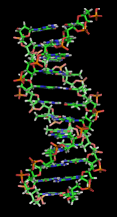 The illustration of the DNA molecule is subtly wrong. It shows a
symmetric molecule. In reality, one of the two grooves between the
strands is about twice as big as the other, as shown at right.
The illustration of the DNA molecule is subtly wrong. It shows a
symmetric molecule. In reality, one of the two grooves between the
strands is about twice as big as the other, as shown at right.
The top formula says that C6H12O6 and
O2 go into the cell; the bottom formula says that CO2 comes
out. (Energy comes out also; I wonder why this wasn't mentioned.)
The notation for chemical compounds here is different from that used
on
page 14: there, O2 was written as

 ;
here it is written as
;
here it is written as


 (“2×O”).
(“2×O”).
The glyph near the left margin  does not appear elsewhere,
but I think it is supposed to mean “cell”. Supposing that is correct,
the text at the bottom says that the number of cells in a man or woman
is !!10^{13}!!. The number of cells in a human is not known, except
very approximately, but !!10^{13}!! is probably the right order of
magnitude. (A
2013 paper from Annals of Human Biology estimates
!!3.72\cdot 10^{13}!!.)
does not appear elsewhere,
but I think it is supposed to mean “cell”. Supposing that is correct,
the text at the bottom says that the number of cells in a man or woman
is !!10^{13}!!. The number of cells in a human is not known, except
very approximately, but !!10^{13}!! is probably the right order of
magnitude. (A
2013 paper from Annals of Human Biology estimates
!!3.72\cdot 10^{13}!!.)
Next to the cell is a ruler labeled !!10^{-5}!! meters, which is a typical size for a eukaryotic cell.
The illustration on the right of the page, annotated with the glyphs
for the four nucleobases from the previous page 


 , depicts the
duplication of genetic material during cellular division. The DNA
molecule splits down the middle like a zipper. The cell then
constructs a new mate for each half of the zipper, and when it
divides, each daughter cell gets one complete zipper.
, depicts the
duplication of genetic material during cellular division. The DNA
molecule splits down the middle like a zipper. The cell then
constructs a new mate for each half of the zipper, and when it
divides, each daughter cell gets one complete zipper.
[Other articles in category /aliens/dd] permanent link
Fri, 02 Oct 2015
A message to the aliens, part 17/23 (DNA chemistry)
Earlier articles: Introduction Common features Page 1 (numerals) Page 2 (arithmetic) Page 3 (exponents) Page 4 (algebra) Page 5 (geometry) Page 6 (chemistry) Page 7 (mass) Page 8 (time and space) Page 9 (physical units) Page 10 (temperature) Page 11 (solar system) Page 12 (Earth-Moon system) Page 13 (days, months, and years) Page 14 (terrain) Page 15 (human anatomy) Page 16 (vital statistics)
This is page 17 of the Cosmic Call message. An explanation follows.

The 10 digits are:
 0 |  1 |  2 |  3 |  4 |  5 |  6 |  7 |  8 |  9 |
This page depicts the chemical structures of the four
nucleobases that make up
the information-carrying part of the DNA molecule. Clockwise from top
left, they are thymine  , adenine
, adenine  , guanine
, guanine  , and cytosine
, and cytosine
 .
.
The deoxyribose and phosphate components of the nucleotides, shown at right, are not depicted. These form the spiral backbone of the DNA and are crucial to its structure. Will the recipients understand why the nucleobases are important enough for us to have mentioned them?
The next article will discuss page 18, shown at right. (Click to enlarge.) Try to figure it out before then.[Other articles in category /aliens/dd] permanent link
Wed, 30 Sep 2015
A message to the aliens, part 16/23 (vital statistics)
Earlier articles: Introduction Common features Page 1 (numerals) Page 2 (arithmetic) Page 3 (exponents) Page 4 (algebra) Page 5 (geometry) Page 6 (chemistry) Page 7 (mass) Page 8 (time and space) Page 9 (physical units) Page 10 (temperature) Page 11 (solar system) Page 12 (Earth-Moon system) Page 13 (days, months, and years) Page 14 (terrain) Page 15 (human anatomy)
This is page 16 of the Cosmic Call message. An explanation follows.

The 10 digits are:
 0 |  1 |  2 |  3 |  4 |  5 |  6 |  7 |  8 |  9 |
This page, about human vital statistics and senses, is in three
sections. The text in the top left explains the population of the
Earth: around 6,000,000,000 people at the time the message was sent.
The three following lines give the life expectancy (70 years), mass
(80 kg), and body temperature (311K) of humans. In each case it is
stated explicitly that the value for men and for women is the same,
which is not really true.
The glyph used for life expectancy  is the same one used
to denote the age of the Earth back on page 13 even though the
two notions are not really the same.
And why 311K when the commonly-accepted value is 310K?
is the same one used
to denote the age of the Earth back on page 13 even though the
two notions are not really the same.
And why 311K when the commonly-accepted value is 310K?
The diagram at right attempts to explain the human sense of hearing,
showing a high-frequency wave at top and a low frequency one at
bottom, annotated with the glyph for frequency  and the upper
and lower frequency limits of human hearing, 20,000 Hz and 20 Hz
respectively. I found this extremely puzzling the first time I
deciphered the message, so much so that it was one of the few parts of
the document that left me completely mystified, even with the advantage
of knowing already what humans are like. A significant part of the
problem here is that the illustration is just flat out wrong. It
depicts transverse waves:
and the upper
and lower frequency limits of human hearing, 20,000 Hz and 20 Hz
respectively. I found this extremely puzzling the first time I
deciphered the message, so much so that it was one of the few parts of
the document that left me completely mystified, even with the advantage
of knowing already what humans are like. A significant part of the
problem here is that the illustration is just flat out wrong. It
depicts transverse waves:
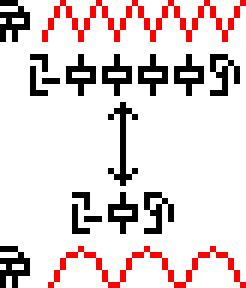
but sound waves are not transverse, they are compression waves. The aliens are going to think we don't understand compression waves. (To see the difference, think of water waves, which are transverse: the water molecules move up and down—think of a bobbing cork—but the wave itself travels in a perpendicular direction, not vertically but toward the shore, where it eventually crashes on the beach. Sound waves are not like this. The air molecules move back and forth, parallel to the direction the sound is moving.)
I'm not sure what would be better; I tried generating some random compression waves to fit in the same space. (I also tried doing a cartoon of a non-random, neatly periodic compression wave, but I couldn't get anything I thought looked good.) I think the compression waves are better in some ways, but perhaps very confusing:
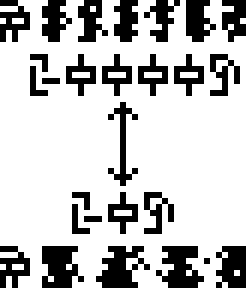
On the one hand, I think they express the intended meaning more
clearly; on the other hand, I think they're too easy to confuse with
glyphs, since they happen to be on almost the same scale. I think
the message might be clearer if a little more space were allotted for
them. Also, they could be annotated with the glyph for pressure  , maybe something like this:
, maybe something like this:
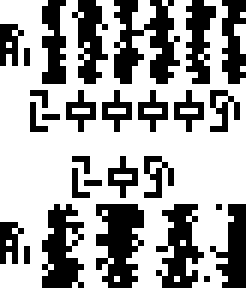
This also gets rid of the meaningless double-headed arrow. I'm not sure I buy the argument that the aliens won't know about arrows; they may not have arrows but it's hard to imagine they don't know about any sort of pointy projectile, and of course the whole purpose of a pointy projectile (the whole point, one might say) is that the point is on the front end. But the arrows here don't communicate motion or direction or anything like that; even as a human I'm not sure what they are supposed to communicate.
The bottom third of the diagram is more sensible. It is a diagram
showing the wavelengths of light  to which the human
visual system is most sensitive. The x-axis is labeled with
“wavelength”
to which the human
visual system is most sensitive. The x-axis is labeled with
“wavelength”  and the
y-axis with a range from 0 to 1. The three peaks have their centers
at 295 nm (blue), 535 nm (green), and 565 nm (often called “red”, but
actually yellow). These correspond to the three types of cone cells
in the retina, and the existence of three different types is why we
perceive the color space as being three-dimensional. (I discussed
this at greater
length a few
years ago.) Isn't it interesting that the “red” and green
sensitivities are so close together? This is why we have red-green
color blindness.
and the
y-axis with a range from 0 to 1. The three peaks have their centers
at 295 nm (blue), 535 nm (green), and 565 nm (often called “red”, but
actually yellow). These correspond to the three types of cone cells
in the retina, and the existence of three different types is why we
perceive the color space as being three-dimensional. (I discussed
this at greater
length a few
years ago.) Isn't it interesting that the “red” and green
sensitivities are so close together? This is why we have red-green
color blindness.
[Other articles in category /aliens/dd] permanent link
Mon, 28 Sep 2015
A message to the aliens, part 15/23 (human anatomy)
Earlier articles: Introduction Common features Page 1 (numerals) Page 2 (arithmetic) Page 3 (exponents) Page 4 (algebra) Page 5 (geometry) Page 6 (chemistry) Page 7 (mass) Page 8 (time and space) Page 9 (physical units) Page 10 (temperature) Page 11 (solar system) Page 12 (Earth-Moon system) Page 13 (days, months, and years) Page 14 (terrain)
This is page 15 of the Cosmic Call message. An explanation follows.

The 10 digits are:
 0 |  1 |  2 |  3 |  4 |  5 |  6 |  7 |  8 |  9 |
This page starts a new section of the document, each page headed with the glyph for “biology”
 . The illustration
is adapted from the Pioneer
plaque; the relevant
portion is shown below.
. The illustration
is adapted from the Pioneer
plaque; the relevant
portion is shown below.

Copies of the plaque were placed on the 1972 and 1973 Pioneer spacecraft. The Pioneer image has been widely discussed and criticized; see the Wikipedia article for some of the history here. The illustration suffers considerably from its translation to a low-resolution bitmap. The original picture omits the woman's vulva; the senders have not seen fit to correct this bit of prudery.
The man and the woman are labeled with the glyphs  and
and  , respectively.
The glyph for “people”
, respectively.
The glyph for “people”  , which identified
the stick figures on the previous page, is inexplicably omitted here.
, which identified
the stick figures on the previous page, is inexplicably omitted here.
 The ruler on the right somewhat puzzlingly goes from a bit above the man's toe
to a bit below the top of the woman's head; it does not measure either of the
two figures. It is labeled 1.8 meters, a typical height for men. The
original Pioneer plaque spanned the woman exactly and gave her height
as 168 cm, which is conveniently an integer multiple of the basic measuring unit (21 cm) defined on the plaque.
The ruler on the right somewhat puzzlingly goes from a bit above the man's toe
to a bit below the top of the woman's head; it does not measure either of the
two figures. It is labeled 1.8 meters, a typical height for men. The
original Pioneer plaque spanned the woman exactly and gave her height
as 168 cm, which is conveniently an integer multiple of the basic measuring unit (21 cm) defined on the plaque.
To prevent the recipients from getting confused about which end of the
body is the top, a parabolic figure (shown here at left), annotated with the glyph
for “acceleration”, shows the direction of gravitational acceleration
as on the previous page.
[Other articles in category /aliens/dd] permanent link
Fri, 25 Sep 2015
A message to the aliens, part 14/23 (terrain)
Earlier articles: Introduction Common features Page 1 (numerals) Page 2 (arithmetic) Page 3 (exponents) Page 4 (algebra) Page 5 (geometry) Page 6 (chemistry) Page 7 (mass) Page 8 (time and space) Page 9 (physical units) Page 10 (temperature) Page 11 (solar system) Page 12 (Earth-Moon system) Page 13 (days, months, and years)
This is page 14 of the Cosmic Call message. An explanation follows.

The 10 digits are:
 0 |  1 |  2 |  3 |  4 |  5 |  6 |  7 |  8 |  9 |
This is my favorite page: there is a lot of varied information and the
illustration is ingenious. The page heading says  to match up with
the corresponding labels on the previous three pages. The page
depicts the overall terrain of the Earth. The main feature is a large
illustration of some mountains (yellow in my highlighted illustration below)
plunging into the sea (blue).
to match up with
the corresponding labels on the previous three pages. The page
depicts the overall terrain of the Earth. The main feature is a large
illustration of some mountains (yellow in my highlighted illustration below)
plunging into the sea (blue).

The land part is labeled  , the air part
, the air part  , and the water part
, and the water part
 . Over on the
left of the land part are little stick figures, labeled people
. Over on the
left of the land part are little stick figures, labeled people  . This is to show
that people live on the land part of the Earth, not under water or in
the air. The stick figures may not be clear to the recipients, but
they are explained in more detail on the next page.
. This is to show
that people live on the land part of the Earth, not under water or in
the air. The stick figures may not be clear to the recipients, but
they are explained in more detail on the next page.
Each of the three main divisions is annotated with its general chemical composition, with compounds listed in order of prevalence., All the chemical element symbols were introduced earlier, on pages 6 and 7:
The lithosphere  :
silicon dioxide (SiO2)
:
silicon dioxide (SiO2)
![]()

 ;
aluminium oxide (Al2O3)
;
aluminium oxide (Al2O3)




 ;
iron(III) oxide (Fe2O3)
;
iron(III) oxide (Fe2O3)




 ;
iron(II) oxide (FeO)
;
iron(II) oxide (FeO)

 . Wikipedia and other sources dispute this listing, giving instead:
SiO2, MgO, FeO,
Al2O3,
CaO, Na2O,
Fe2O3 in that order.
. Wikipedia and other sources dispute this listing, giving instead:
SiO2, MgO, FeO,
Al2O3,
CaO, Na2O,
Fe2O3 in that order.
The atmosphere  :
nitrogen gas (N2)
:
nitrogen gas (N2)

 ;
oxygen gas (O2)
;
oxygen gas (O2)

 ;
argon (Ar)
;
argon (Ar)
 ;
carbon dioxide (CO2)
;
carbon dioxide (CO2)


 .
.
The hydrosphere  :
water (H2O)
:
water (H2O)


 ;
sodium (Na)
;
sodium (Na)
 ;
chlorine (Cl)
;
chlorine (Cl)
 .
.
There are rulers extending upward from the surface of the water to the height of top of the mountain and downward to the bottom of the ocean. The height ruler is labeled 8838 meters, which is the height the peak of Mount Everest, the point highest above sea level. The depth ruler is labeled 11000 meters, which is the depth of the Challenger Deep in the Mariana Trench, the deepest part of the ocean. The two rulers have the correct sizes relative to one another. The human figures at left are not to scale (they would be about 1.7 miles high), but the next page will explain how big they really are.
I don't think the message contains anything to tell the recipients the temperature of the Earth, so it may not be clear that the hydrosphere is liquid water. But perhaps the wavy line here will suggest that. The practice of measuring the height of the mountains and depth of the ocean from the surface may also be suggestive of a liquid ocean, since it would not otherwise have a flat surface to provide a global standard.
 There is a potential problem with this picture: how will the
recipients know which edge is the top? What if they hold it
upside-down, and think the human figures are pointing down into the
earth, heads downwards?
There is a potential problem with this picture: how will the
recipients know which edge is the top? What if they hold it
upside-down, and think the human figures are pointing down into the
earth, heads downwards?
This problem is solved in a clever way: the dots at the right of the
page depict an object accelerating under the influence of gravity,
falling in a characteristic parabolic path. To make the point clear,
the dots are labeled with the glyph  for
acceleration.
for
acceleration.
Finally, the lower left of the page states the  acceleration due to gravity at the Earth's surface, 9.7978
m/s2. The recipients can calculate this value from the
mass and radius of the Earth given earlier. Linked with the other
appearance of acceleration on the page, this should suggest that the
dots depict an object falling under the influence of gravity toward
the bottom of the page.
acceleration due to gravity at the Earth's surface, 9.7978
m/s2. The recipients can calculate this value from the
mass and radius of the Earth given earlier. Linked with the other
appearance of acceleration on the page, this should suggest that the
dots depict an object falling under the influence of gravity toward
the bottom of the page.
[Other articles in category /aliens/dd] permanent link
Wed, 23 Sep 2015
A message to the aliens, part 13/23 (days, months, and years)
Earlier articles: Introduction Common features Page 1 (numerals) Page 2 (arithmetic) Page 3 (exponents) Page 4 (algebra) Page 5 (geometry) Page 6 (chemistry) Page 7 (mass) Page 8 (time and space) Page 9 (physical units) Page 10 (temperature) Page 11 (solar system) Page 12 (Earth-Moon system)
This is page 13 of the Cosmic Call message. An explanation follows.

The 10 digits are:
 0 |  1 |  2 |  3 |  4 |  5 |  6 |  7 |  8 |  9 |
There are three diagrams on this page, each depicting something going around. Although the direction is ambiguous (unless you understand arrows) it should at least should be clear that all three rotations are in the same direction. This is all you can reasonably say anyhow, because the rotations would all appear to be going the other way if you looked at them from the other side.
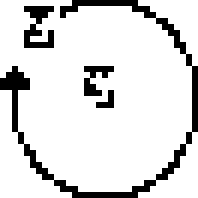 The upper left diagram depicts the Earth
The upper left diagram depicts the Earth  going around the
Sun
going around the
Sun  and
underneath is a note that says that the time
and
underneath is a note that says that the time  is equal to
315569268 seconds, and is also equal to one year
is equal to
315569268 seconds, and is also equal to one year  . This defines the
year.
. This defines the
year.
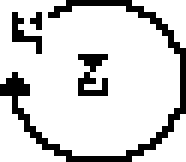 The upper-right
diagram depicts the Moon
The upper-right
diagram depicts the Moon  going around the
Earth
going around the
Earth  ; the
notation says that this takes 2360591 seconds, or around 27⅓
days. This is not the 29½ days that one might naïvely expect, because
it is the sidereal month rather than the synodic month. Suppose the
phase of the Moon is new, so that the Moon lies exactly between the
Earth and the Sun. 27⅓ days later the Moon has made a complete trip around
the Earth, but because the Earth has moved, the Moon is not yet again
on the line between the Earth and the Sun; the line is in a different
direction. The Earth has moved about !!\frac1{13}!! of the way around
the sun, so it takes about another !!\frac1{12}\cdot 27\frac13!! days
before the moon is again between Earth and Sun and so a total of about
29½ days between new moons.
; the
notation says that this takes 2360591 seconds, or around 27⅓
days. This is not the 29½ days that one might naïvely expect, because
it is the sidereal month rather than the synodic month. Suppose the
phase of the Moon is new, so that the Moon lies exactly between the
Earth and the Sun. 27⅓ days later the Moon has made a complete trip around
the Earth, but because the Earth has moved, the Moon is not yet again
on the line between the Earth and the Sun; the line is in a different
direction. The Earth has moved about !!\frac1{13}!! of the way around
the sun, so it takes about another !!\frac1{12}\cdot 27\frac13!! days
before the moon is again between Earth and Sun and so a total of about
29½ days between new moons.
 The lower-right diagram depicts the rotation of the Earth, giving a time of
86163 seconds for the day. Again, this is not the 86400 seconds one
would expect, because it is the sidereal day rather than the solar
day; the issue is the same as in the previous paragraph.
The lower-right diagram depicts the rotation of the Earth, giving a time of
86163 seconds for the day. Again, this is not the 86400 seconds one
would expect, because it is the sidereal day rather than the solar
day; the issue is the same as in the previous paragraph.
None of the three circles appears to be circular. The first one is nearly circular, but it looks worse than it is because the Sun has been placed off-center. The curve representing the Moon's orbit is decidedly noncircular. This is reasonable, because the Moon's orbit is elliptical to approximately the same degree. In the third diagram, the curve is intended to represent the surface of the Earth, so its eccentricity is indefensible. The ellipse is not the same as the one used for the Moon's orbit, so it wasn't just a copying mistake.
The last two lines state that the ages of the Sun and the Earth are each
4550000000 years. This is the first appearance of the glyph
 for “age”.
for “age”.
[Other articles in category /aliens/dd] permanent link
Mon, 21 Sep 2015
A message to the aliens, part 12/23 (earth-moon system)
Earlier articles: Introduction Common features Page 1 (numerals) Page 2 (arithmetic) Page 3 (exponents) Page 4 (algebra) Page 5 (geometry) Page 6 (chemistry) Page 7 (mass) Page 8 (time and space) Page 9 (physical units) Page 10 (temperature) Page 11 (solar system)
This is page 12 of the Cosmic Call message. An explanation follows.

The 10 digits are:
 0 |  1 |  2 |  3 |  4 |  5 |  6 |  7 |  8 |  9 |
Page 12, begins a new section of the document, with pages headed with
the glyph  “Earth”, describing the Earth and its environs. This will help the recipients locate our planet, should they come to visit.
“Earth”, describing the Earth and its environs. This will help the recipients locate our planet, should they come to visit.
The top of the page
has a diagram of the Earth  -Moon
-Moon  system and a ruler
labeled with the distance between them, !!3844\cdot 10^5!! meters. Since the distance between Earth and Moon varies (the orbit is elliptical) an average value is given.
system and a ruler
labeled with the distance between them, !!3844\cdot 10^5!! meters. Since the distance between Earth and Moon varies (the orbit is elliptical) an average value is given.

The glyph used here for distance,  , is different
from the one defined on page 9
, is different
from the one defined on page 9  . Neither
appears elsewhere in the message, so this is probably a mistake.
. Neither
appears elsewhere in the message, so this is probably a mistake.
The following five lines give the mass  and radius
and radius  of the Moon and the Earth, and also the distance from the Earth to the Sun. The latter would have been better on the previous page, which discussed the solar system, but was omitted from there for some reason.
of the Moon and the Earth, and also the distance from the Earth to the Sun. The latter would have been better on the previous page, which discussed the solar system, but was omitted from there for some reason.
[Other articles in category /aliens/dd] permanent link
Fri, 18 Sep 2015
A message to the aliens, part 11/23 (solar system)
Earlier articles: Introduction Common features Page 1 (numerals) Page 2 (arithmetic) Page 3 (exponents) Page 4 (algebra) Page 5 (geometry) Page 6 (chemistry) Page 7 (mass) Page 8 (time and space) Page 9 (physical units) Page 10 (temperature)
This is page 11 of the Cosmic Call message. An explanation follows.

The 10 digits are:
 0 |  1 |  2 |  3 |  4 |  5 |  6 |  7 |  8 |  9 |
Page 11, headed with the glyph for “physics”  is evidently a
chart of the solar system, with the Sun
is evidently a
chart of the solar system, with the Sun  at left. The Earth
at left. The Earth
 is also
labeled, as is Jupiter
is also
labeled, as is Jupiter  , the planet most
likely to be visible to the recipients. The “Jupiter” glyph does not appear again.
Pluto is included, as it was still considered a planet in 1999. (Pluto's
status as only one of many similar trans-Neptunian objects was not
well appreciated in 1999 when the message was composed, the second TNO
having only been discovered in 1992.)
To the extent permitted by the low resolution of the image,
The diameters of the planets and
the Sun are to scale,
but not their relative positions; the page is
much too small for that. Saturn's rings are not shown, as they are in
the Pioneer plaque; by
this time it was appreciated that ring systems may be common around large
planets.
, the planet most
likely to be visible to the recipients. The “Jupiter” glyph does not appear again.
Pluto is included, as it was still considered a planet in 1999. (Pluto's
status as only one of many similar trans-Neptunian objects was not
well appreciated in 1999 when the message was composed, the second TNO
having only been discovered in 1992.)
To the extent permitted by the low resolution of the image,
The diameters of the planets and
the Sun are to scale,
but not their relative positions; the page is
much too small for that. Saturn's rings are not shown, as they are in
the Pioneer plaque; by
this time it was appreciated that ring systems may be common around large
planets.
The masses
 and radii
and radii
 of Jupiter and the Sun are given, Jupiter above
the illustration and the Sun below. The (external) temperature
of Jupiter and the Sun are given, Jupiter above
the illustration and the Sun below. The (external) temperature  of the Sun
is also given, 5763 kelvins. This should be visible to the aliens
because the Sun is a blackbody emitter and the spectrum of blackbody
radiation is a clear indicator of its temperature. This data should
allow the aliens to locate us, should they be so inclined: they know
which way the message came from, and can look for a star with the
right size and temperature in that direction. When they get closer,
Jupiter and the sizes of the planets will provide a confirmation that
they are in the right place. Later pages explain that we live on the
Earth, so the aliens will know where to point their fusion cannon in
order to obliterate our planet.
of the Sun
is also given, 5763 kelvins. This should be visible to the aliens
because the Sun is a blackbody emitter and the spectrum of blackbody
radiation is a clear indicator of its temperature. This data should
allow the aliens to locate us, should they be so inclined: they know
which way the message came from, and can look for a star with the
right size and temperature in that direction. When they get closer,
Jupiter and the sizes of the planets will provide a confirmation that
they are in the right place. Later pages explain that we live on the
Earth, so the aliens will know where to point their fusion cannon in
order to obliterate our planet.
[Other articles in category /aliens/dd] permanent link
Wed, 16 Sep 2015
A message to the aliens, part 10/23 (temperature)
Earlier articles: Introduction Common features Page 1 (numerals) Page 2 (arithmetic) Page 3 (exponents) Page 4 (algebra) Page 5 (geometry) Page 6 (chemistry) Page 7 (mass) Page 8 (time and space) Page 9 (physical units)
This is page 10 of the Cosmic Call message. An explanation follows.

The 10 digits are:
 0 |  1 |  2 |  3 |  4 |  5 |  6 |  7 |  8 |  9 |
The top half of this page is a table of melting points (on the left)
and boiling points (on the right) for various substances: hydrogen
 , carbon
, carbon
 , sulfur
, sulfur
 , zinc
, zinc  , silver
, silver  , and gold
, and gold  . The temperatures
are given in kelvins
. The temperatures
are given in kelvins  .
.
The boiling points depend on pressure, so there is a notation at the
bottom of the list that the pressure  should be
101300 pascals
should be
101300 pascals  . This is one standard atmosphere, so it may tell the aliens a
little more about our planet.
. This is one standard atmosphere, so it may tell the aliens a
little more about our planet.
To help calibrate the kelvins, the bottom of the page is a chart
of the temperature
increase of water


 , showing how the temperature stops increasing at the
melting point (273K) and the boiling point (373K). This introduces the
glyph for temperature
, showing how the temperature stops increasing at the
melting point (273K) and the boiling point (373K). This introduces the
glyph for temperature  , which will recur later.
, which will recur later.
There are two
regrettable things about this chart. One is that the horizontal axis
is labeled “time”
 . Why is the
temperature of the water increasing with time? It should be energy.
. Why is the
temperature of the water increasing with time? It should be energy.
But a more serious complaint, I think, it that this is the wrong
chart. It depends crucially on the (Earth-)standard atmospheric pressure,
with which the recipients may not be familiar. And the kelvin is not defined
in terms of standard pressure anyway. It is defined in terms of the
triple point of water, the unique, universal temperature and pressure at which
all three states of water can coexist. Why not a temperature and
pressure chart with the triple point labeled? This is something one
might more reasonably expect the aliens to have studied.
[Other articles in category /aliens/dd] permanent link
Mon, 14 Sep 2015
A message to the aliens, part 9/23 (physical units)
Earlier articles: Introduction Common features Page 1 (numerals) Page 2 (arithmetic) Page 3 (exponents) Page 4 (algebra) Page 5 (geometry) Page 6 (chemistry) Page 7 (mass) Page 8 (time and space)
This is page 9 of the Cosmic Call message. An explanation follows.
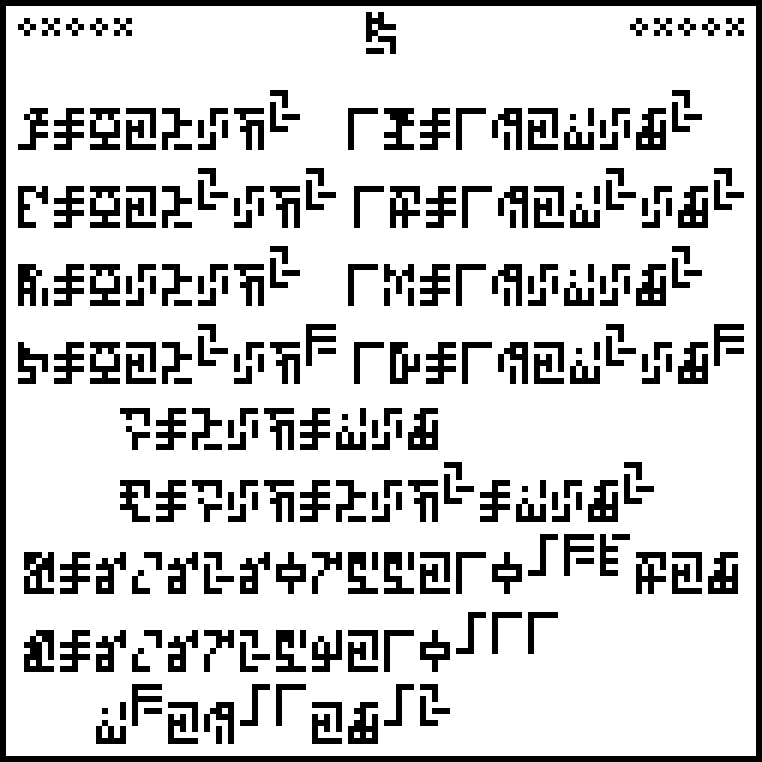
The 10 digits are:
 0 |  1 |  2 |  3 |  4 |  5 |  6 |  7 |  8 |  9 |
The previous two pages defined fundamental units of mass, distance, and time. This page adds some derived notions: force, energy, pressure, and power; velocity and acceleration.
The first four lines are in two parts each. The left part defines an
abstract quantity like force or energy; the right part defines a unit
of that quantity like newtons or joules. For example, the second line defines energy and units of energy. The left side says that energy
 is equal to mass
is equal to mass
 times distance
times distance
 squared divided by time
squared divided by time  squared. (This is the first appearance of the glyphs for distance and time.)
The right side says that a joule
squared. (This is the first appearance of the glyphs for distance and time.)
The right side says that a joule
 of energy is !!1\frac{\mathrm{kg}\,\mathrm{m}^2}{\mathrm{s}^2}!!.
of energy is !!1\frac{\mathrm{kg}\,\mathrm{m}^2}{\mathrm{s}^2}!!.
The two following lines define the abstract concepts of velocity  (which has
appeared before in connection with the speed of light) and
acceleration
(which has
appeared before in connection with the speed of light) and
acceleration  (which is
new). There are no units given for these.
(which is
new). There are no units given for these.
| Concept |  force |  energy |  pressure |  power |  velocity |  acceleration |
|---|---|---|---|---|---|---|
| Unit |  newton |  joule |  pascal |  watt | (none) | (none) |
The newton and the joule won't appear again. Force won't appear again except on the last page, which asks “force WTF?”.
The final part of the page is the most interesting. It mentions the
Planck constant !!h!!
 (not the related !!\hbar!!) which is
!!6.6260755\cdot 10^{{}^-34}!! joule-seconds and the universal gravitation constant !!G!!
(not the related !!\hbar!!) which is
!!6.6260755\cdot 10^{{}^-34}!! joule-seconds and the universal gravitation constant !!G!!
 which is !!6.67259\cdot 10^{{}^-11}\; \mathrm{m}^3\;
\mathrm{kg}^{{}^-1}\; \mathrm{s}^{{}^-2}!!.
which is !!6.67259\cdot 10^{{}^-11}\; \mathrm{m}^3\;
\mathrm{kg}^{{}^-1}\; \mathrm{s}^{{}^-2}!!.
It's quite possible that the recipients won't recognize the gravitational constant, which is tricky to measure directly. Newton's law of universal gravitation was known on Earth for hundreds of years before the value of !!G!! was worked out. But if the recipients don't know it, they will be able to work it out from the later statements about the mass and radius of the Earth and the gravitational force at its surface, This would in turn allow them to calculate the mass of their own planet.
Note that on this page some inverse units are written with a division sign and some with a negative exponent. Will this inconsistency puzzle the aliens? My coworker Jeff Ober suggests that it communicates the important personal information that humans are confused and inconsistent.
The next article will discuss page 10, shown at right. (Click to enlarge.) Try to figure it out before then.[Other articles in category /aliens/dd] permanent link
Thu, 10 Sep 2015
A message to the aliens, part 8/23 (time and space)
Earlier articles: Introduction Common features Page 1 (numerals) Page 2 (arithmetic) Page 3 (exponents) Page 4 (algebra) Page 5 (geometry) Page 6 (chemistry) Page 7 (mass)
This is page 8 of the Cosmic Call message. An explanation follows.
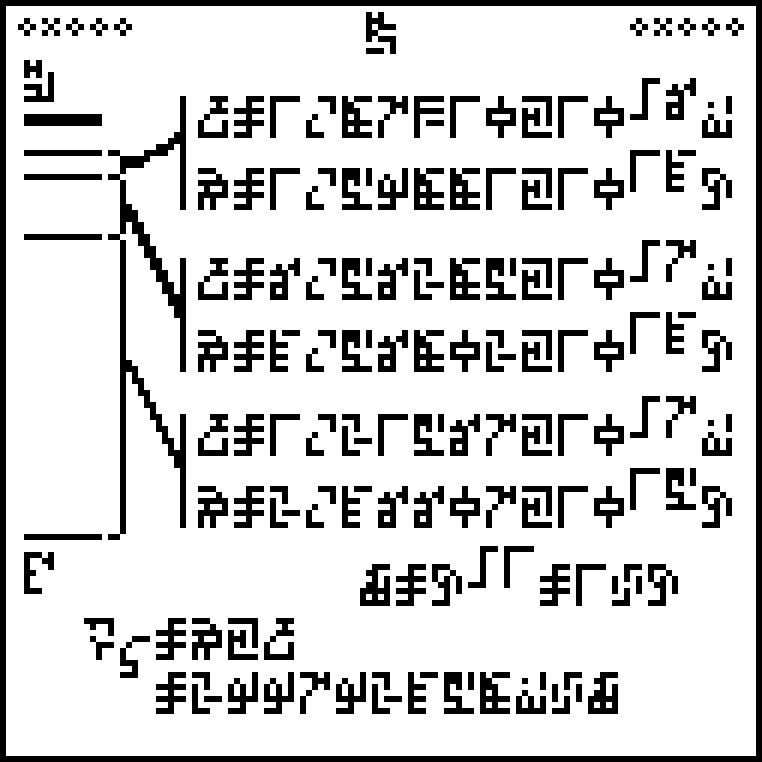
The 10 digits are:
 0 |  1 |  2 |  3 |  4 |  5 |  6 |  7 |  8 |  9 |

The main feature of this page is a diagram of the electron energy
levels for a hydrogen atom, annotated at the top with the glyph for
hydrogen  and at the bottom with the glyph for energy
and at the bottom with the glyph for energy  . The four lowest
levels are shown, with the lowest level (the ground state) at the
bottom. Above these is a thicker bar representing the way the higher
energy levels all pile up into a smear. If the bottom level is at 0
and the smear is at 1, then the three intermediate levels are
shown at approximately their exact values of !!\frac34, \frac89, !! and !!\frac{15}{16}!!; these are
given by the Rydberg
formula.
. The four lowest
levels are shown, with the lowest level (the ground state) at the
bottom. Above these is a thicker bar representing the way the higher
energy levels all pile up into a smear. If the bottom level is at 0
and the smear is at 1, then the three intermediate levels are
shown at approximately their exact values of !!\frac34, \frac89, !! and !!\frac{15}{16}!!; these are
given by the Rydberg
formula.
The aliens should be familiar with hydrogen. Normally a hydrogen atom's sole electron is in the ground state. If a photon couples with the electron, say because starlight is falling on the atom, or someone has applied an electric current to it, the electron may jump up to a higher quantum state. (This is the only correct use of the phrase "quantum leap".) When it drops back down, it will emit a photon. But the energy of the emitted photon must be one of a few particular values, corresponding to the difference between the old and the new energy level; the electron never drops down partway to the next level. An incandescent cloud of hydrogen gas will not typically glow in every possible color; it will emit light in only a few particular, characteristic wavelengths, and these colors can be separated with a spectroscope. The wavelengths of these characteristic colors of light, visible everywhere the message is likely to reach, provide a basis for defining the meter.
For example, the second pair of numbers labels the transition from the !!n=3!! to the !!n=2!! state, and an electron transiting between these two states will always emit a photon with a wavelength of 656.2852 nanometers and a frequency of 456.8021 terahertz, and these are the two numbers in the pair. The product of the two numbers in each pair is a constant, which should further confirm to the recipients that they have the right interpretation. The constant product is close to 299792458, which is the speed of light in meters per second. This defines four glyphs, for wavelength and frequency, and meters and hertz.
 wavelength |  frequency |  meters |  hertz |  seconds |
The following item

defines the second  as the inverse of
the hertz (written as !!\mathrm{Hz}^{{}^-1}!! and as
!!1\div\mathrm{Hz}!!).
as the inverse of
the hertz (written as !!\mathrm{Hz}^{{}^-1}!! and as
!!1\div\mathrm{Hz}!!).
Finally, the speed  of light
of light  is given, first
theoretically, as the product of wavelength and frequency
is given, first
theoretically, as the product of wavelength and frequency 

 and then
numerically, as 299792458 meters per second
and then
numerically, as 299792458 meters per second 

 .
.
Try to figure it out before then.
[Other articles in category /aliens/dd] permanent link
Wed, 09 Sep 2015
A message to the aliens, part 7/23 (mass)
Earlier articles: Introduction Common features Page 1 (numerals) Page 2 (arithmetic) Page 3 (exponents) Page 4 (algebra) Page 5 (geometry) Page 6 (chemistry)
This is page 7 of the Cosmic Call message. An explanation follows.
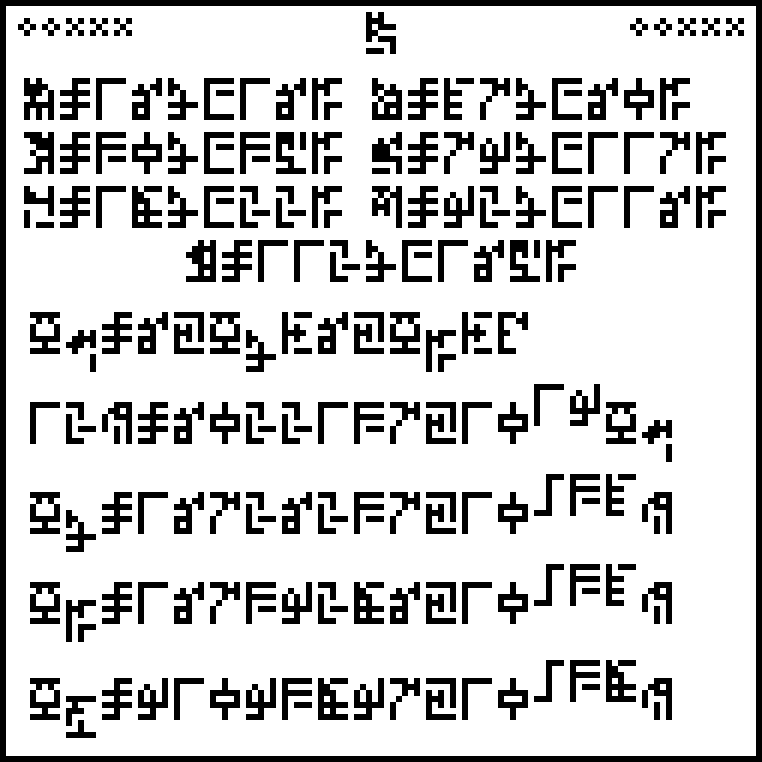
The 10 digits are:
 0 |  1 |  2 |  3 |  4 |  5 |  6 |  7 |  8 |  9 |
Page 7 discusses mass and defines the kilogram.
The top section of the page continues the table of chemical elements
from the previous page, giving the number of protons and neutrons.
For example, gold  is described as having 79 protons
is described as having 79 protons  and 117 neutrons
and 117 neutrons
 .
.
 Sulfur |  Zinc |  Argon |  Silver |  Gold |  Uranium |  Copernicium |
Copernicium, element 112, had been discovered but not named at the time the document was written.
There is a major error here.
Uranium
 is given as having 92 protons and 116
neutrons. There is no such substance. It should have said 146
neutrons.
is given as having 92 protons and 116
neutrons. There is no such substance. It should have said 146
neutrons.

I sometimes imagine the aliens, having received the message, come to visit us. “We weren't going to bother,” they say, “but we had to know about the uranium-208.” And then we will have to tell them that we messed up. Ouch. (It could be an error for lead-208 or bismuth-208 instead; one can't be sure because the glyph does not appear elsewhere in the document.)
I'd been planning to write that paragraph about uranium-208 for more
than ten years, but it wasn't until just now that I realized there is
a much more serious mistake two lines down, so that the uranium is no longer
the most serious error that I know of in the entire document. The
line after the table of elements says that the mass of a carbon atom is the mass of six
protons plus the mass of six neutrons plus “energy”,  , by which I think
they mean the binding energy in the nucleus. This is the first
appearance of the glyph for energy, which will recur later. And then
the following line commits a really horrible boner, one that has the
potential to spoil the whole message.
, by which I think
they mean the binding energy in the nucleus. This is the first
appearance of the glyph for energy, which will recur later. And then
the following line commits a really horrible boner, one that has the
potential to spoil the whole message.
With the mass of the carbon nucleus pinned down, the authors want to
define the kilogram  : the document
says that 12 kilograms is the mass of !!6022137\cdot 10^{19} !!
carbon-12 atoms. That !!6022137\cdot 10^{19} !! is Avogadro's number.
Except it's not. Avogadro's number is usually given as
!!6.022137\cdot 10^{23} !!, and this number is 100 times that big.
But it should be 1000 times that big.
: the document
says that 12 kilograms is the mass of !!6022137\cdot 10^{19} !!
carbon-12 atoms. That !!6022137\cdot 10^{19} !! is Avogadro's number.
Except it's not. Avogadro's number is usually given as
!!6.022137\cdot 10^{23} !!, and this number is 100 times that big.
But it should be 1000 times that big.
Normally, one would say that !!6.022137\cdot 10^{23} !! carbon atoms mass 12 grams, but there are two confusing factors here. One is that the authors have written !!6022137!! instead of !!6.022137!! and the other is that they are defining 12 kilograms instead of 12 grams. But it should be that !!6.022137\cdot 10^{23} = 6022137\cdot 10^{17}!! atoms is 12 grams so that !!6022137\cdot 10^{20}!! atoms is 12 kilograms, and the number written is instead !!6022137 10^{19}!! atoms, making the kilogram 90% smaller than it should have been.

It's possible that the aliens can figure this out, because it is detectably inconsistent with the following statements about the masses of the fundamental particles in kilograms. But it may not be clear to the recipients which of the two definitions of the kilogram is the correct one. Especially given the—I really hate to report this—the typo in the second statement.
The three following lines give the masses of the proton, neutron, and electron in kilograms. These are all more or less correct (although the book values have changed since the message were written) and I think the value for the neutron has a typo; it says !!1.6739286\cdot 10^{{}^-34}!! kg but it probably should have been !!1.67{\mathit 4}9286\cdot 10^{{}^-34}!! kg which would agree with the current book value of !!1.674927351\cdot 10^{{}^-34}!! kg.

Since we're going over the errors on this page, here is yet another
oddity. The number of neutrons in a gold atom
 is given at the top of
the page as 117. Unlike uranium-208., the isotope gold-196 actually exists. But it is radioactive,
breaking down into platinum or mercury after about a week. One would
expect the listing to be for gold-197 instead, which is the only
stable isotope and so is the only isotope occurring in naturally-found
gold. (Thanks to Peter Annema for bringing this to my attention.)
A similar oddity occurs in the listing for zinc
is given at the top of
the page as 117. Unlike uranium-208., the isotope gold-196 actually exists. But it is radioactive,
breaking down into platinum or mercury after about a week. One would
expect the listing to be for gold-197 instead, which is the only
stable isotope and so is the only isotope occurring in naturally-found
gold. (Thanks to Peter Annema for bringing this to my attention.)
A similar oddity occurs in the listing for zinc
 :
zinc-65 is given instead of the stable zinc-64 or zinc-66.
The
other isotopes listed here (sulfur-32, argon-40, silver-107) are more
plausible.
:
zinc-65 is given instead of the stable zinc-64 or zinc-66.
The
other isotopes listed here (sulfur-32, argon-40, silver-107) are more
plausible.
[Other articles in category /aliens/dd] permanent link
Fri, 21 Aug 2015
A message to the aliens, part 6/23 (chemistry)
Earlier articles: Introduction Common features Page 1 (numerals) Page 2 (arithmetic) Page 3 (exponents) Page 4 (algebra) Page 5 (geometry)
This is page 6 of the Cosmic Call message. An explanation follows.
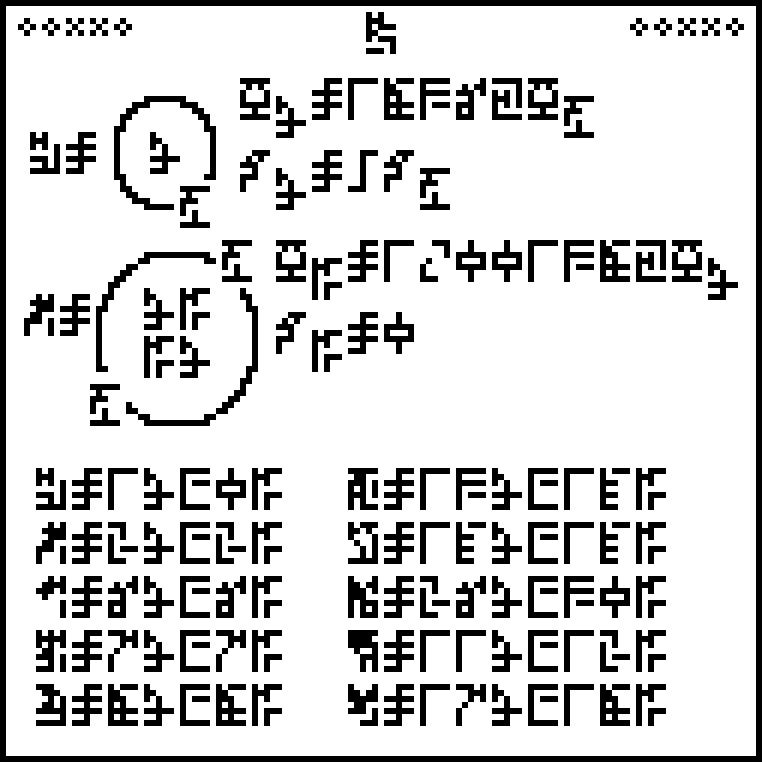
The 10 digits again:
 0 |  1 |  2 |  3 |  4 |  5 |  6 |  7 |  8 |  9 |
Page 6 discusses fundamental particles of matter, the structure of the hydrogen and helium atoms, and defines glyphs for the most important chemical elements.
Depicted at top left is the hydrogen atom, with a proton  in the center and
an electron
in the center and
an electron  circulating
around the outside. This diagram is equated to the glyph
circulating
around the outside. This diagram is equated to the glyph  for hydrogen.
for hydrogen.
The diagram for helium  is similar but has two electrons, and its nucleus has two protons and
also two
is similar but has two electrons, and its nucleus has two protons and
also two
 neutrons.
neutrons.
 Proton |  Neutron |  Electron |
The illustrations may puzzle the aliens, depending on how they think of atoms. (Feynman once said that this idea of atoms as little solar systems, with the electrons traveling around the nucleus like planets, was a hundred years old and out of date.) But the accompanying mass and charge data should help clear things up. The first formula says

!!M_p = 1836\cdot M_e!!
the mass of the proton is 1836 times the mass of the electron, and that 1836, independent of the units used and believed to be a universal and fundamental constant, ought to be a dead giveaway about what is being discussed here.
If you want to communicate fundamental constants, you have a bit of a problem. You can't tell the aliens that the speed of light is !!1.8\cdot10^{12}!! furlongs per fortnight without first explaining furlongs and fortnights (as is actually done on a later page). But the proton-electron mass ratio is dimensionless; it's 1836 in every system of units. (Although the value is actually known to be 1836.15267; I don't know why a more accurate value wasn't given.)
This is the first use of subscripts in the document. It also takes
care of introducing the symbol  for mass. The
following formula does the same for charge
for mass. The
following formula does the same for charge  : !!Q_p = -Q_e!!.
: !!Q_p = -Q_e!!.
The next two formulas, accompanying the illustration of the helium
atom, describe the mass (1.00138 protons) and charge (zero) of the
neutron. I wonder why the authors went for the number 1.00138 here
instead of writing the neutron-electron mass ratio of 1838 for
consistency with the previous ratio. I also worry that this won't be
enough for the aliens to be sure about the meaning of  . The 1836 is as
clear as anything can be, but the 0 and -1 of the corresponding charge
ratios could in principle be a lot of other things. Will the context
be enough to make clear what is being discussed? I suppose it has to; charge, unlike mass, comes in discrete units and there is nothing like the 1836.
. The 1836 is as
clear as anything can be, but the 0 and -1 of the corresponding charge
ratios could in principle be a lot of other things. Will the context
be enough to make clear what is being discussed? I suppose it has to; charge, unlike mass, comes in discrete units and there is nothing like the 1836.
The second half of the page reiterates the symbols for hydrogen and
helium and defines symbols for eight other chemical elements. Some of
these appear in organic compounds that will be discussed later; others
are important constituents of the Earth. It also
introduces symbol for “union” or “and”:  . For example,
sodium is described as having 11 protons and 12 neutrons.
. For example,
sodium is described as having 11 protons and 12 neutrons.
 Hydrogen |  Helium |  Carbon |  Nitrogen |  Oxygen |  Aluminium | Silicon |  Iron |  Sodium |  Chlorine |
Most of these new glyphs are not especially mnemonic, except for hydrogen—and aluminium, which is spectacular.
The blog is going on hiatus until early September. When it returns, the next article will discuss page 7, shown at right. It has three errors. Can you find them? (Click to enlarge.)[Other articles in category /aliens/dd] permanent link
Wed, 19 Aug 2015
A message to the aliens, part 5/23 (geometry)
Earlier articles: Introduction Common features Page 1 (numerals) Page 2 (arithmetic) Page 3 (exponents) Page 4 (algebra)
This is page 5 of the Cosmic Call message. An explanation follows.
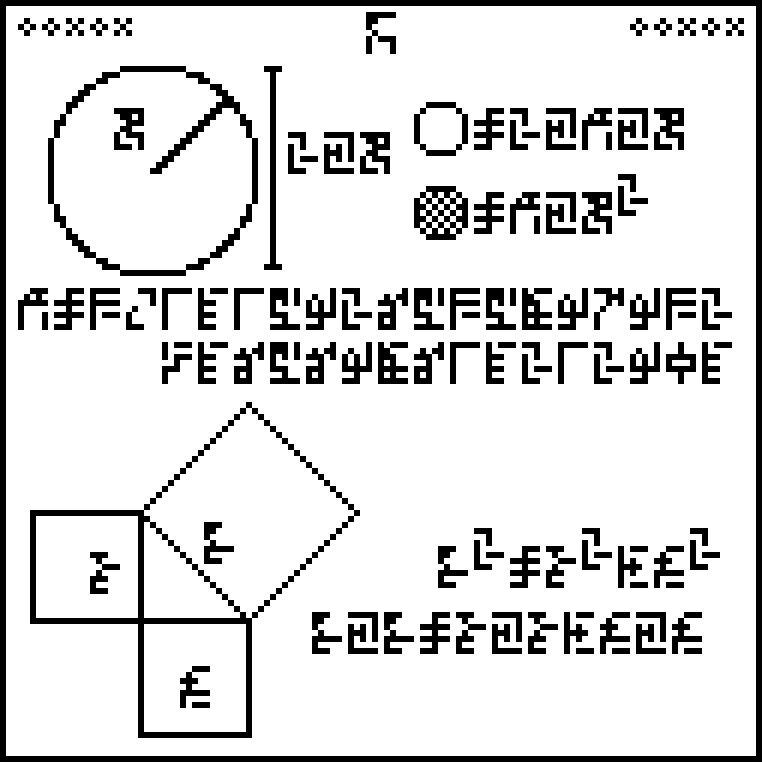
The 10 digits again:
 0 |  1 |  2 |  3 |  4 |  5 |  6 |  7 |  8 |  9 |
Page 5 discusses two basic notions of geometry. The top half concerns
circles and introduces !!\pi!!. There is a large circle with its
radius labeled  :
:

The outer
diameter is then 

 which is !!2\cdot r!!.
which is !!2\cdot r!!.
The perimeter
 is twice
is twice
 times the radius
times the radius
 ,
and the area
,
and the area
 is
is
 times the square of the radius
times the square of the radius  . What is
. What is  ? It's !!\pi!! of
course, as the next line explains, giving !!\pi =
3.1415926545697932…365698614212904!!, which gives enough digits on the
front to make clear what is being communicated. The trailing digits
are around the 51 billionth places and communicate part of the state
of our knowledge of !!\pi!!. I almost wish the authors had included
a sequence of fifteen random digits at this point, just to keep the aliens
wondering.
? It's !!\pi!! of
course, as the next line explains, giving !!\pi =
3.1415926545697932…365698614212904!!, which gives enough digits on the
front to make clear what is being communicated. The trailing digits
are around the 51 billionth places and communicate part of the state
of our knowledge of !!\pi!!. I almost wish the authors had included
a sequence of fifteen random digits at this point, just to keep the aliens
wondering.
The bottom half of the page is about the pythagorean theorem. Here
there's a rather strange feature. Instead of using the three variables
from the previous page,


 ,
the authors changed the second one and used
,
the authors changed the second one and used


 instead. This new
instead. This new  glyph does not
appear anywhere else. A mistake, or did they do it on purpose?
glyph does not
appear anywhere else. A mistake, or did they do it on purpose?
In any case, the pythagorean formula is repeated twice, once with exponents and once without, as both !!z^2=x^2+b^2!! and !!z\cdot z = x\cdot x + b\cdot b!!. I think they threw this in just in case the exponentiation on the previous pages wasn't sufficiently clear. I don't know why the authors chose to use an isosceles right triangle; why not a 3–4–5 or some other scalene triangle, for maximum generality? (What if the aliens think we think the pythagorean theorem applies only for isosceles triangles?) But perhaps they were worried about accurately representing any funny angles on their pixel grid. I wanted to see if it would fit, and it does. You have to make the diagram smaller, but I think it's still clear:
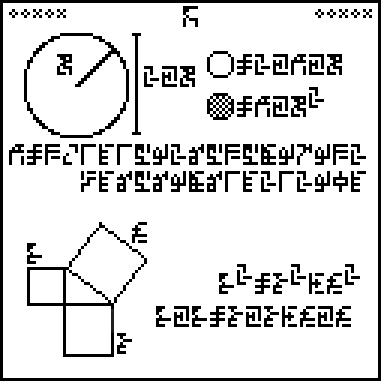
(I made it smaller than it needed to be and then didn't want to redo it.)
I hope this section will be sufficiently unmistakable that the aliens will see past the oddities.
The next article will discuss page 6, shown at right. (Click to enlarge.) Try to figure it out before then.[Other articles in category /aliens/dd] permanent link
Mon, 17 Aug 2015
A message to the aliens, part 4/23 (algebra)
Earlier articles: Introduction Common features Page 1 (numerals) Page 2 (arithmetic) Page 3 (exponents)
This is page 4 of the Cosmic Call message. An explanation follows.
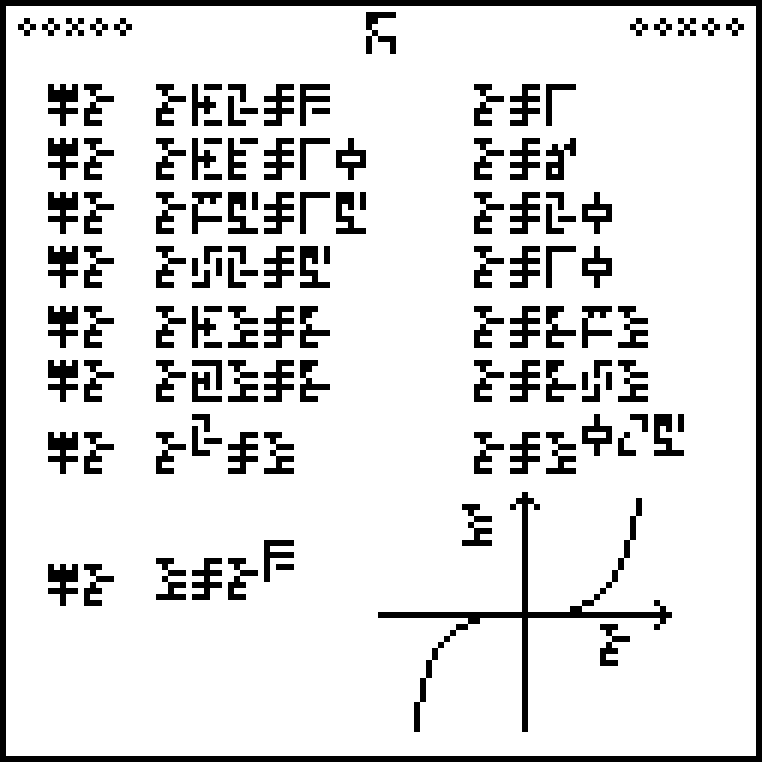
Reminder: page 1 explained the ten digits:
 0 |  1 |  2 |  3 |  4 |  5 |  6 |  7 |  8 |  9 |
And the equal sign  .
Page 2 explained the four basic arithmetic operations and some associated notions:
.
Page 2 explained the four basic arithmetic operations and some associated notions:
 addition |  subtraction |  multiplication |  division |  negation |  ellipsis (…) |  decimal point |  indeterminate |
This page, headed with the glyph for “mathematics”  , describes the solution of simple algebraic equations and defines glyphs for three variables, which we may as well call !!x,y,!! and !!z!!:
, describes the solution of simple algebraic equations and defines glyphs for three variables, which we may as well call !!x,y,!! and !!z!!:
 x |  y |  z |
Each equation is introduced by the locution 
 which means “solve
for !!x!!”. This somewhat peculiar “solve” glyph will not appear
again until page 23.
which means “solve
for !!x!!”. This somewhat peculiar “solve” glyph will not appear
again until page 23.
For example the second equation is !!x+4=10!!:

Solve for !!x!!: !!x+4=10!!
The solution, 6, is given over on the right:

!!x=6!!
After the fourth line, the equations to be solved change from simple numerical equations in one variable to more abstract algebraic relations between three variables. For example, if

Solve for !!x!!: !!x\cdot y=z!!
then

!!x=z\div y!!.
The next-to-last line uses a decimal fraction in the exponent,
!!0.5!!:
 . On the previous page, the rational fraction !!1\div 2!! was
used. Had the same style been followed, it would have looked like this:
. On the previous page, the rational fraction !!1\div 2!! was
used. Had the same style been followed, it would have looked like this:
 .
.
Finally, the last line defines !!x=y^3!! and then, instead of an algebraic solution, gives a graph of the resulting relation, with axes labeled. The scale on the axes is not the same; the !!x!!-coordinate increases from 0 to 20 pixels, but the !!y!!-coordinate increases from 0 to 8000 pixels because !!20^3 = 8000!!. If axes were to the same scale, the curve would go up by 8,000 pixels. Notice that the curve does not peek above the !!x!!-axis until around !!x=8, y=512!! or so. The authors could have stated that this was the graph of !!y=x^3\div 400!!, but chose not to.

I also wonder what the aliens will make of the arrows on the axes. I think the authors want to show that our coordinates increase going up and to the left, but this seems like a strange and opaque way to do that. A better choice would have been to use a function with an asymmetric graph, such as !!y=2^x!!.
(After I wrote that I learned that similar concerns were voiced about the use of a directional arrow in the Pioneer plaque.
(Wikipedia says: “An article in Scientific American criticized the use of an arrow because arrows are an artifact of hunter-gatherer societies like those on Earth; finders with a different cultural heritage may find the arrow symbol meaningless.”)
The next article will discuss page 5, shown at right. (Click to enlarge.) Try to figure it out before then.[Other articles in category /aliens/dd] permanent link
Fri, 14 Aug 2015
A message to the aliens, part 3/23 (exponentiation)
Earlier articles: Introduction Common features Page 1 (numerals) Page 2 (arithmetic)
This is page 3 of the Cosmic Call message. An explanation follows.
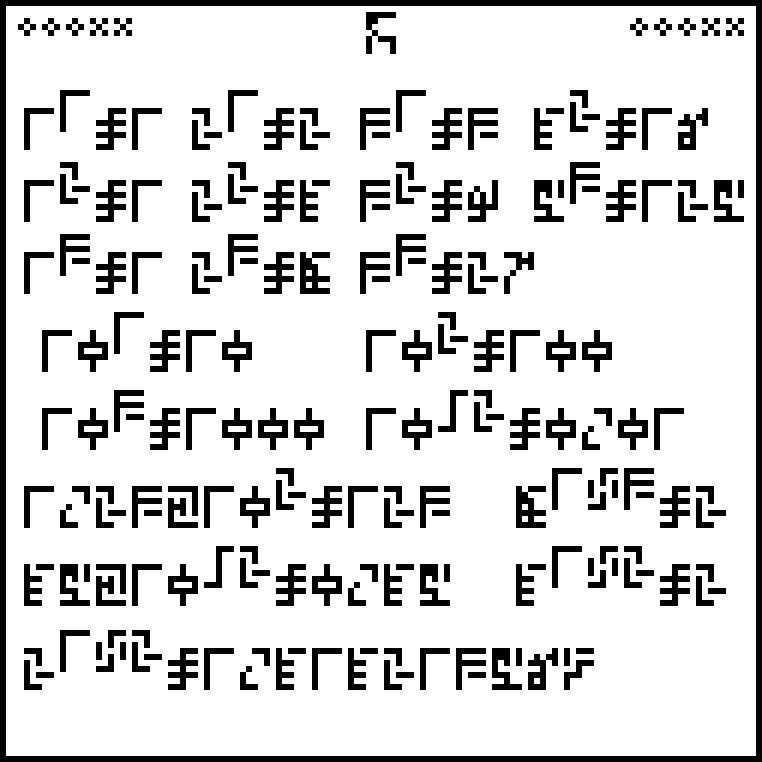
Reminder: page 1 explained the ten digits:
 0 |  1 |  2 |  3 |  4 |  5 |  6 |  7 |  8 |  9 |
And the equal sign  .
Page 2 explained the four basic arithmetic operations and some associated notions:
.
Page 2 explained the four basic arithmetic operations and some associated notions:
 addition |  subtraction |  multiplication |  division |  negation |  ellipsis (…) |  decimal point |  indeterminate |
This page, headed with the glyph for “mathematics”  , explains
notations for exponentiation and scientific notation. (This notation
was first used on page 1 in the mersenne prime
, explains
notations for exponentiation and scientific notation. (This notation
was first used on page 1 in the mersenne prime  .)
.)
Exponentiation could be represented by an operator, but instead the authors have chosen to represent it by a superscripted position on the page, as is done in conventional mathematical notation. This saves space.
The top section of the page has small examples of exponentiation, including for example !!5^3=125!!:

!!5^3=125!!
There is a section that follows with powers of 10: !!10^1=10, 10^2=100, 10^3=1000, !! and more interestingly !!10^{{}^-2} = 0.01!!:

!!10^{{}^-2} = 0.01!!
This is a lead-in to the next section, which expresses various quantities in scientific notation, which will recur frequently later on. For example, !!0.045!! can be written as !!45\times 10^{{}^-2}!!:

!!45\times10^{{}^-2} = 0.45!!
Finally, there is an offhand remark about the approximate value of the square root of 2:

!!2^{1\div 2} = 1.41421356…!!
[Other articles in category /aliens/dd] permanent link
Wed, 12 Aug 2015
A message to the aliens, part 2/23 (arithmetic)
Earlier articles: Introduction Common features Page 1 (numerals)
This is page 2 of the Cosmic Call message. An explanation follows.
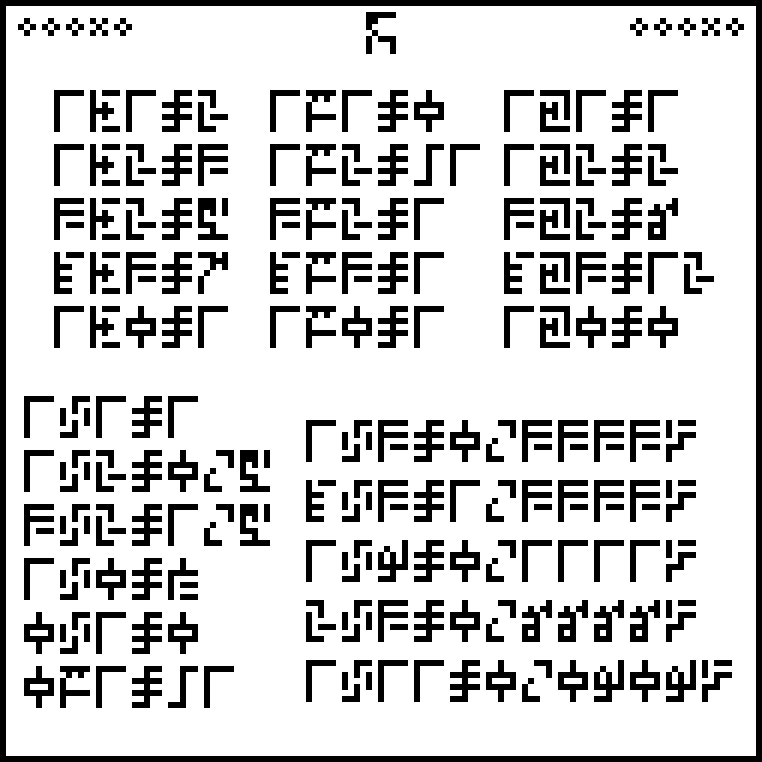
Reminder: the previous page explained the ten digits:
 0 |  1 |  2 |  3 |  4 |  5 |  6 |  7 |  8 |  9 |
This page, headed with the glyph for “mathematics”  , explains the arithmetic operations on numbers.
, explains the arithmetic operations on numbers.
The page is in five sections, three on top and two below.
The first four sections explain
addition  ,
subtraction
,
subtraction  ,
multiplication
,
multiplication  , and
division
, and
division  . Each is explained with a series of five typical arithmetic equalities. For example, !!4\times 3= 12!!:
. Each is explained with a series of five typical arithmetic equalities. For example, !!4\times 3= 12!!:

The subtraction sign actually appeared back on page 1
in the Mersenne prime !!2^{3021377}-1!!  .
.
The negative sign  is introduced in
connection with subtraction, since !!1-2={}^-1!!:
is introduced in
connection with subtraction, since !!1-2={}^-1!!:

Note that the negative-number sign is not the same as the subtraction sign.
The decimal point  is
introduced in connection with division. For example, !!3\div 2 =
1.5!!:
is
introduced in connection with division. For example, !!3\div 2 =
1.5!!:

There is also an attempt to divide by zero:

It's not clear what the authors mean by this; the mysterious glyph
 does
not appear anywhere else in the document. What did they think it
meant? Infinity? Indeterminate? Well, I found out later they
published a cheat sheet, which assigns the meaning “undetermined” to
this glyph. Not a great choice, in my opinion, because !!1÷0!! is not
numerically equal to anything.
does
not appear anywhere else in the document. What did they think it
meant? Infinity? Indeterminate? Well, I found out later they
published a cheat sheet, which assigns the meaning “undetermined” to
this glyph. Not a great choice, in my opinion, because !!1÷0!! is not
numerically equal to anything.
For some reason, perhaps because of space limitations, the authors have stuck the equation !!0-1 = {}^-1!! at the bottom of the division section.
The fifth section, at lower right, displays some nonterminating decimal fractions and introduces
 the ellipsis or ‘…’ symbol. For example, !!1\div 9 = 0.1111\ldots!!:
the ellipsis or ‘…’ symbol. For example, !!1\div 9 = 0.1111\ldots!!:

I would have put !!2÷27 = 0.0740…!! here instead of !!2\div 3!!, which I think is too similar to the other examples.
The next article, to appear 2015-08-14, will discuss page 3, shown at right. (Click to enlarge.) Try to figure it out before then.[Other articles in category /aliens/dd] permanent link
A message to the aliens, part 1/23 (numbers)
Earlier articles: Introduction Common features
This is page 1 of the Cosmic Call message. An explanation follows.
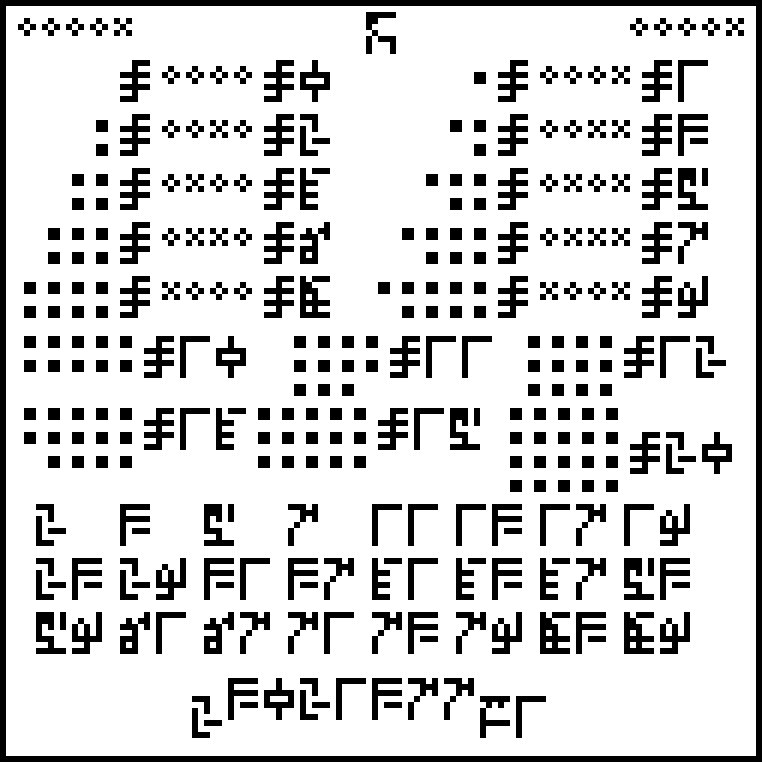
This page, headed with the glyph for “mathematics”  , explains
the numeral symbols that will be used throughout the rest of the
document. I should warn you that these first few pages are a little
dull, establishing basic mathematical notions. The good stuff comes a
little later.
, explains
the numeral symbols that will be used throughout the rest of the
document. I should warn you that these first few pages are a little
dull, establishing basic mathematical notions. The good stuff comes a
little later.
The page is in three sections. The first section explains the individual digit symbols. A typical portion looks like this:

•••• ••• = 0111 = 7
Here the number 7 is written in three ways: first, as seven dots,
probably unmistakable. Second, as a 4-bit binary number, using the
same bit symbols that are used in the page numbers. The three forms
are separated by the glyph  , which means “equals”.
The ten digits, in order from 0 to 9, are represented by the glyphs
, which means “equals”.
The ten digits, in order from 0 to 9, are represented by the glyphs
 0 |  1 |  2 |  3 |  4 |  5 |  6 |  7 |  8 |  9 |
The authors did a great job selecting glyphs that resemble the numerals they represent. All have some resemblance except for 4, which has 4 horizontal strokes. Watch out for 4; it's easy to confuse with 3.
The second section serves two purposes. It confirms the meaning of the ten digits, and it also informs the aliens that the rest of the message will write numerals in base ten. For example, the number 14:

••••• ••••• •••• = 14
Again, there are 14 dots, an equal sign, and the numeral 14, this time
written with the two glyphs  (1) and
(1) and  (4). The base-2
version is omitted this time, to save space. The aliens know from this
that we are using base 10; had it been, say, base 8, the glyphs would
have been
(4). The base-2
version is omitted this time, to save space. The aliens know from this
that we are using base 10; had it been, say, base 8, the glyphs would
have been 
 .
.
People often ask why the numbers are written in base 10, rather than say in base 2. One good answer is: why not? We write numbers in base 10; is there a reason to hide that from the aliens? The whole point of the message is to tell the aliens a little bit about ourselves, so why disguise the fact that we use base-10 numerals? Another reason is that base-10 numbers are easier to proofread for the humans sending the message.
The third section of the page is a list of prime numbers from 2 to 89:

67, 71, 73, 79, 83
and finally the number !!2^{3021377}-1!!
 ,
,
!!2^{3021377}-1!!
I often wonder what the aliens will think of the !!2^{3021377}-1!!. Will they laugh at how cute we are, boasting about the sweet little prime number we found? Or will they be astounded and wonder why we think we know that such a big number is prime?
The next article, to appear 2015-08-12, will discuss page 2, shown at right. (Click to enlarge.) Try to figure it out before then.[Other articles in category /aliens/dd] permanent link
Sun, 09 Aug 2015
A message to the aliens, part 0/23 (framing)
Earlier articles: Introduction
(At left is page 1 of the Cosmic Call message. For an enlarged version of the image, click it.)
First, some notes about the general format of each page. The Cosmic Call message was structured as 23 pages, each a 127×127 bitmap. The entire message was therefore 127×127×23 bits, and this would hopefully be suggestive to the aliens: they could try decoding it as 127 pages of 127×23-bit images, which would produce garbage, or as 23 pages of 127×127-bit images, which is correct. Or they might try decoding it as a single 127×2921-bit image, which would also work. But the choices are quite limited and it shouldn't take long to figure out which one makes sense.
 To
assist in the framing, each page of the message is surrounded by a
border of black pixels and then a second smaller border of white
pixels. If the recipient misinterpreted the framing of the bit sequence,
say by supposing that the message was made of lines of 23 pixels, it
would be immediately apparent that something was wrong, as at right.
At the very least the regular appearance of the black border pixels
every 127 positions, and the fact that the message began with 128
black pixels, would suggest that there was something significant about
that number. If the aliens fourier-transform the message, there
should be a nice big spike at the 127 mark.
To
assist in the framing, each page of the message is surrounded by a
border of black pixels and then a second smaller border of white
pixels. If the recipient misinterpreted the framing of the bit sequence,
say by supposing that the message was made of lines of 23 pixels, it
would be immediately apparent that something was wrong, as at right.
At the very least the regular appearance of the black border pixels
every 127 positions, and the fact that the message began with 128
black pixels, would suggest that there was something significant about
that number. If the aliens fourier-transform the message, there
should be a nice big spike at the 127 mark.
Most of the message is encoded as a series of 5×7-pixel glyphs. The glyphs were generated at random and then subject to later filtering: candidate glyphs were discarded unless they differed from previous glyphs in enough bit positions. This was to help the recipients reconstruct the glyphs if some of the bits were corrupted in transmission, as is likely.
The experimenters then eyeballed the glyphs and tried to match glyphs
with their meanings in a way that would be easy for humans to
remember, to aid in proofreading. For example, the glyph they chose
to represent the digit 7 was  .
.
People frequently ask why the message uses strange glyphs instead of standard hindu-arabic numerals. This is explained by the need to have the glyphs be as different as possible. Communication with other stars is very lossy. Imagine trying to see a tiny flickering light against the background of a star at a distance of several light years. In between you and the flickering light are variable dust and gas clouds. Many of the pixels are likely to be corrupted in transmission. The message needs to survive this corruption. So glyphs are 35 bits each. Each one differs from the other glyphs in many positions, whereas a change of only a few pixels could change a standard 6 into an 8 or vice versa. A glyph is spread across multiple lines of the image, which makes it more resistant to burst errors: even if an entire line of pixels is destroyed in transit, no entire glyph will be lost.
At the top left and top right of each page are page numbers. For
example, page number 1:  The page numbers
are written in binary, most significant bit first, with
The page numbers
are written in binary, most significant bit first, with
 representing a 1 bit and
representing a 1 bit and  representing a 0 bit. These bit
shapes were chosen to be resistant to data corruption; you can change
any 4 of the 9 pixels in either shape and the recipient can still
recover the entire bit unambiguously. There is an ambiguity about
whether the numerals are written right to left or left to right—is
representing a 0 bit. These bit
shapes were chosen to be resistant to data corruption; you can change
any 4 of the 9 pixels in either shape and the recipient can still
recover the entire bit unambiguously. There is an ambiguity about
whether the numerals are written right to left or left to right—is
 the number 1
or the number 16?—but the aliens should be able to figure it out by
comparing page numbers on consecutive pages; this in turn will help
them when time comes for them to figure out the digit symbols.
the number 1
or the number 16?—but the aliens should be able to figure it out by
comparing page numbers on consecutive pages; this in turn will help
them when time comes for them to figure out the digit symbols.
Every page has a topic header, in this case  , which roughly means
“mathematics”. The topics of the following pages are something like:
, which roughly means
“mathematics”. The topics of the following pages are something like:
- 1–5 Mathematics

- 6–11,21 Physics

- 12–14,19–20 The Earth

- 15–18 Human anatomy and biochemistry

- 22 Cosmology

- 23 Questions

In the next article I'll explain the contents of page 1. Each following article will appear two or three days later and will explain another page.
To follow the whole series of articles in your feed reader, subscribe to: RSS Atom
(Next article, to appear 2015-08-10: page 1)
[Other articles in category /aliens/dd] permanent link
Thu, 06 Aug 2015
A message to the aliens (introduction)
In 1999, two Canadian astrophysicists, Stéphane Dumas and
Yvan Dutil, composed and sent a message into space. The message
was composed of twenty-three pages of bitmapped data, and was sent
from the RT-70
radio telescope in Yevpatoria, Ukraine, as part of a set of
messages called Cosmic
Call.
The message images themselves are extremely compelling. I saw the first one in the book Beyond Contact by Brian McConnell:

Sometimes when I gave conference talks, I would put this image on the screen during break, to give people something to think about before the class started up again. I like to say that it's fun to see if you're as smart as an alien, or at least if as smart as the Canadian astrophysicists thought the aliens would be.
I invite you to try to understand what is going on in the first image, above. In a day or two I will post a full explanation, along with the second image. Over the next few weeks I hope to write a series of blog articles about the 23 pages, explaining the details of each.
If you can't wait that long for the full set, you can browse them here, or download a zip file.
Addendum 20151223: The series is now complete. The full set of articles is:
- Common features
- Page 1 (numerals)
- Page 2 (arithmetic)
- Page 3 (exponents)
- Page 4 (algebra)
- Page 5 (geometry)
- Page 6 (chemistry)
- Page 7 (mass)
- Page 8 (time and space)
- Page 9 (physical units)
- Page 10 (temperature)
- Page 11 (solar system)
- Page 12 (Earth-Moon system)
- Page 13 (days, months, and years)
- Page 14 (terrain)
- Page 15 (human anatomy)
- Page 16 (vital statistics)
- Page 17 (DNA chemistry)
- Page 18 (cell respiration and division)
- Pages 19-20 (map of the Earth)
- Page 21 (the message)
- Page 22 (cosmology)
- Page 23 (wat)
[Other articles in category /aliens/dd] permanent link
Fri, 15 May 2009
"Known to Man" and the advent of the space aliens
Last week I wrote about how I
was systematically changing the phrase "known to man" to just "known"
in Wikipedia articles.
Two people so far have written to warn me that I would regret this once the space aliens come, and I have to go around undoing all my changes. But even completely leaving aside Wikipedia's "Wikipedia is not a crystal ball" policy, which completely absolves me from having to worry about this eventuality, I think these people have not analyzed the situation correctly. Here is how it seems to me.
Consider these example sentences:
- Diamond is the hardest substance known to man.
- Diamond is the hardest substance known.
There are four possible outcomes for the future:
- Aliens reveal superhardium, a substance harder than diamond.
- Aliens exist, but do not know about superhardium.
- The aliens do not turn up, but humans discover superhardium on their own.
- No aliens and no superhardium.
In cases (1) and (3), both sentences require revision.
In case (4), neither sentence requires revision.
But in case (2), sentence (a) requires revision, while (b) does not. So my change is a potential improvement in a way I had not appreciated.
Also in last week's article, I said it would be nice to find a case where a Wikipedia article's use of "known to man" actually intended a contrast with divine or feminine knowledge, rather than being a piece of inept blather. I did eventually find such a case: the article on runic alphabet says, in part:
In the Poetic Edda poem Rígþula another origin is related of how the runic alphabet became known to man. The poem relates how Ríg, identified as Heimdall in the introduction, ...
I gratefully acknowledge the gift of Thomas Guest. Thank you!
[Other articles in category /aliens] permanent link
Thu, 27 Apr 2006
Yellow
Most of the academic part of high school is mercifully gone from my
memory, dissolved together into a uniform blur of dullness. I wrote recently about one
question I remember fondly from one final exam. I only remember a few
specific exam questions, and probably that is the only one I remember
because it was such a good question.
The one exam question that sticks most clearly in my mind was from my eighth-grade science class: What color do you see if you look at a yellow light through a monochromatic red filter?
I said it would look red, and was marked wrong. I argued my answer with the teacher, Mr. Goodman, but he would not give me credit. I puzzled over this for a long time, and eventually understood what had happened.
The word "yellow" is not a designation of physics alone; it refers to a certain experience, and is a perceptual phenomenon, not a purely physical one. It's possible to phrase the question to avoid this, but the question was not phrased in that way; it was expressly phrased in perceptual terms. A person who was achromatopsic might see a yellow light through a monochomatic red filter in a very unusual way.
To bring up the possibility of achromatopsia in the context of an exam is just nitpicking; I mention it only to point out that the question, as posed, must involve a consideration of human perception. And the objection I raised at the time is certainly not just nitpicking, because there are two entirely different physical phenomena that both go by the name of "yellow". The confusion of these two things occurs in the human retina.
The perception of color is a very complicated business, and I can't explain it in complete detail today. Partly this is because it isn't understood in complete detail, partly because I don't know everything that is understood, and partly it is because this article is about something else, and I want to try to come to the point eventually. So all my assertions about color perception in this article should be taken as metaphors for what is really happening. Although they give a correct general idea of a perceptual process that is something like what actually occurs, they are not accurate and are not intended to be accurate.
With that warning in place, I will now explain human color perception. Color is sensed by special "cone cells" in the retina. Different cone cells are sensitive to different frequencies of photons. Cone cells come in three types, which we will call "red", "green", and "blue", although all three of these are misnomers to one degree or another. The "red" cone cells are sensitive to red and yellow photons; the "green" cone cells to yellow and green photons. We will ignore the blue cones.
Photons with a wavelength of around 570 nanometers stimulate both the red and the green cone cells, and this stimulation is eventually perceived as the color yellow. But you can stimulate the cone cells the same way without using any light with a frequency around 570 nm. If you bombard the retina with photons of 650 nm, you stimulate only the red cones, and the light looks red; if you bombard the retina with photons of 520 nm, you stimulate only the green cones, and the light looks green. If you bombard the retina with both kinds of photons at once, both the red and green cones are stimulated, just as they were by the 570 nm photons. They have no way to know that they are being stimulated by two different groups of photons instead of by the same group, so the perception is the same.
This is why your computer monitor and your television can display the color yellow, despite having no source of yellow light. The monitor has little red phosphors and little green phosphors. When it activates both of them at once, the red and green photons stream out and get into your eye, where they stimulate the red and green cones, and you perceive the color yellow.
But from a purely physical point of view, this "yellow" phenomenon is not at all like the one that occurs when you look at a lemon or at a sodium vapor street light. The photons coming off the lemon are all of about the same frequency, around 570 nm. The photons coming off the computer monitor picture of the lemon are two different frequencies, some around 520 nm, and some around 650 nm. Your eye is not equipped to tell the difference.
Now, suppose you are looking at "yellow light" through a monochromatic red filter that passes only 650 nm photons. What do you see?
Well, if it was monochomatic yellow light, say from a lemon, then you see nothing, because the filter stops the 570 nm photons. This was Mr. Goodman's exam answer.
But if it was the yellow light that comes from a television picture of a lemon, then it contains some 520 nm photons, which are stopped by the filter, and some 650 nm photons, which are not stopped. You would see a red lemon. This was my exam answer.
The perception of mixed red and green light as yellow was part of the curriculum that year---we had had a classroom demonstration of it---and so it was fair game for the exam. Mr. Goodman's exam question, as posed, was genuinely ambiguous. There are two physical phenomena that are both described as "yellow", and he could have meant either one.
This confusion of two distinct physical phenomena by the retina is something we take for granted, but it is by no means inevitable. I often imagine our meeting with the aliens, and their surprise when they learn that all of us, every human on earth, are color-blind. They will find this out quickly, as soon as they see a television or a computer monitor. "Your monitor is broken," Zxaxgr will say.
"It looks all right to me," replies Flash Gordon.
"Is there something wrong with your eyes? The color adjustment for yellow is completely off. It is coming out as redgreen instead of as yellow."
"I see nothing wrong with the color adjustment for yellow," replies Flash.
"There must be something wrong with your eyes."
And yes, Zxaxgr is right. There is something wrong with our eyes. There is an intrinsic design flaw in our computer monitors, none of which can display yellow, and we don't care, because none of us can tell the difference between redgreen and yellow.
To empathize with Zxaxgr's puzzlement, imagine how strange it would be to learn that the alien televisions cannot display green; they display purple instead: purple trees, purple broccoli, purple frogs, purple flags of Saudi Arabia. And the aliens have never noticed the problem. You want to ask them about it, but your English-to-Alien dictionary doesn't have an entry for "purple". When you ask them about it, they say you're nuts, everything looks green, as it should. You learn that they have no word for purple; they just call it green, and eventually you find out that it's because they can't tell the difference between purple and green.
Whatever you're thinking now, that's what Zxaxgr is going to think.
[Other articles in category /aliens] permanent link
Sat, 18 Mar 2006
Mysteries of color perception
Color perception is incredibly complicated, and almost the only
generalization of it that can be made is "everything you think you
know is probably wrong." The color wheel, for example, is totally
going to flummox the aliens, when they arrive. "What the heck do you
mean, 'violet is a mixture of red and blue'? Violet is nothing
like red. Violet is less like red than any other color except
ultraviolet! Red is even less like violet than it is like blue, for
heaven's sake. What is wrong with you people?"
Well, what is wrong with us is that, because of an engineering oddity in our color sensation system, we think red and violet look somewhat similar, and more alike than red and green.
But anyway, my real point was to note that the colors in  look a lot different against
a gray background than they do against the blue background in the bar
on the left. People who read this blog through an aggregator are just
going to have to click through the link for once.
look a lot different against
a gray background than they do against the blue background in the bar
on the left. People who read this blog through an aggregator are just
going to have to click through the link for once.
[Other articles in category /aliens] permanent link
Fri, 17 Mar 2006
More on Emotions
In yesterday's
long article about emotions, I described the difficulty like
this:
There's another kind of embarrassment that occurs when you see something you shouldn't. For example, you walk into a room and see your mother-in-law putting on her bra. You are likely to feel embarrassed. What's the connection with the embarrassment you feel when you fall off a ledge? I don't know; I'm not even sure they are the same. Perhaps we need a new word.This morning I mentioned to Lorrie that the idea of "embarrassment" seemed to cover two essentially different situations. She told me that our old friend Robin Bernstein had noticed this also, and had suggested that the words "enza" and "zenza" be used respectively for the two feelings of embarrassment for one's self and for embarrassment for other people.
I also thought of another emotion that was not on my list of basic emotions, but seems different from the others. This emotion does not, so far as I know, have a word in English. It is the emotion felt (by most people) when regarding a happy baby, the one that evokes the "Awwww!" response.
 This is a very powerful response in most people, for
evolutionarily obvious reasons. It is so powerful that it is even
activated by baby animals, dolls, koala bears, toy ducks, and, in
general, anything small and round. Even, to a slight extent, ball
bearings. (Don't you find ball bearings at least a little bit cute?
I certainly do.)
This is a very powerful response in most people, for
evolutionarily obvious reasons. It is so powerful that it is even
activated by baby animals, dolls, koala bears, toy ducks, and, in
general, anything small and round. Even, to a slight extent, ball
bearings. (Don't you find ball bearings at least a little bit cute?
I certainly do.)
The aliens might or might not have this emotion. If they are aliens who habitually protect and raise their young, I think it is inevitable. The aliens might be the type to eat their young, in which case they probably will not feel this way, although they might still have that response to their eggs, in which case expect them to feel warmly about ball bearings.
I also gave some more thought to Ashley, the Pacemate who claimed that her most embarrassing moment was crashing into the back of a trash truck and totaling her car. I tried to understand why I found this such a strange response. The conclusion I finally came to was that I had found it inappropriate because I would have expected fear, anger, or guilt to predominate. If Ashley is in a vehicle colision severe enough to ruin her car, I felt, she should experience fear for her own safety or that of others, anger at having wrecked her car, guilt at having carelessly damaged someone else's property or health. But embarrassment suggested to me that her primary concern was for her reputation: now the whole world thinks that Ashley is a bad driver.
 If you don't see what I'm getting at here, the following situational
change might make it clearer:
If you don't see what I'm getting at here, the following situational
change might make it clearer:
Most Embarrassing momentYou almost crippled seventy schoolkids? Gosh, that must have been embarrassing!Ashley (alternate universe version): Crashing into the back of a school bus full of kids and totaling my car!
Having made the analysis explicit for myself, and pinned down what seemed strange to me about Ashley's embarrassment, it no longer seems so strange to me. Here's why: It wasn't a school bus, but a garbage truck. Garbage trucks are big and heavy. The occupants were much less likely to have been injured than was Ashley herself, partly because they were in a truck and also because Ashley struck the back of the truck and not the front. The truck was almost certainly less severely damaged than Ashley's car was, perhaps nearly unscathed. And of course it was impossible that the truck's cargo was damaged. So a large part of the motivation for fear and guilt is erased, simply because the other vehicle in the collision was a garbage truck. I would have been angry that my car was wrecked, but if Ashley isn't, who am I to judge? Probably she's just a better person than I am.
But I still find the reaction odd. I wonder if some of what Ashley takes to be embarrassment isn't actually disgust. But at least I no longer find it completely bizarre.
Finally, thinking about this led me to identify another emotion that I think might belong on the master list: relief.
[Other articles in category /aliens] permanent link
Thu, 16 Mar 2006
Emotions
I was planning to write another article about π, and its appearance
in Coulomb's law, or perhaps an article about how to calculate the volume
of a higher-dimensional analogue of a sphere.
But John Speno says he always skips the math stuff on my blog, and the last couple of days have been unrelievedly mathematical. So instead, John, I have written an article about the comparison of emotions, whether the 18-toed Sirian ghost worms will understand why you are holding your nose, Homer Simpson, the evolutionary justification for disgust, the Indiana Pacers cheerleading squad, Paris Hilton, and maggots. Skip this, I dare you.
My shrink had a little trope that she'd trot out when she asked me how I had felt about something and I wasn't sure. "Mad, sad, glad, scared," she'd say, and that was helpful, because those four do cover an awful lot of situations. And learning to recognize those four is very important.
But one day she pushed the idea too far and asserted that those were the only emotions there are.
That's clearly wrong. Even discounting emotions that might be considered variations on the big four, such as: (anger) rage, annoyance, resentment, frustration, (sadness) grief, disappointment, remorse, loneliness, (happiness) delight, joy, pride, (fear) nervousness, dread, terror, panic, and so on, we still have:
- Boredom
- Disgust
- Envy
- Guilt
- Jealousy
- Lust
- Shame
- Surprise
Some of these may require explanation. People sometimes use the word "disgust" metaphorically to refer to a feeling that is really nine parts anger to one part boredom, as when they say they are disgusted with the state of American politics. But that's not what I mean by it here. The disgust I'm referring to is the feeling you have when you have been on vacation and come back to discover that the power went out while you were away and the meat in the refrigerator has spoiled and slid out onto the kitchen floor where it is now festering with thousands of squirming, white, eyeless maggots, and the instant you see it, your reaction is to (a) turn away, (b) hold your nose, and (c) vomit. I suppose it's possible that some people would have that very reaction to American politics; it's certainly understandable. But I don't think that's what people usually mean when they say that politics disgusts them. Or if they do mean it, they mean it only in a hyperbolic sense.
People often confuse guilt and shame, but they are really orthogonal. You feel guilt when you have done something you believe is ethically or morally wrong. You feel shame when other people observe you doing something that they shouldn't see, whether or not that thing is ethically or morally wrong. The problem is with the observing, not with the thing that is being observed. I think the following example will help clear up the confusion: One might or might not feel guilty about picking one's nose, although I think most people don't feel guilty when they do it. But even someone who picks their nose entirely without guilt, probably feels ashamed if someone else catches them in the act.
The other two that are often confused are envy and jealousy. Here I think the confusion is caused simply because people don't know what the words mean. Envy is what you feel when you want what someone else has; you can envy someone else's car or their lunch or their special relationship with their lover. Jealousy is much more specific. You are jealous when you have a special relationship with a person, and you are afraid that you are going to lose them to a third person. You can envy someone else's possession of a ham sandwich, but jealousy of a ham sandwich is impossible.
I might be willing to believe the proposition these eight, plus the original four (anger, sadness, happiness, and fear) constitute a complete set of "primary colors" for human emotion, and that you can consider the others as being mixtures of various amounts of these twelve. For example, you go up on stage to accept an award, and your trousers fall off, and you feel embarrassed. What is embarrassment? It's maybe five parts shame, two parts fear, and one part surprise. Take away any of these three things, and you no longer have embarrassment, but something else. Add in anger and you have humiliation.
If someone wants to argue that jealousy is compounded from fear, anger, and envy, and should be removed from the list in favor of affection or confusion, I won't complain. The list is necessarily dependent on culture, and even more so on the individual making it. Not every culture will have anything like jealousy; perhaps most won't. Romantic love seems to be a uniquely European invention, dating from around the 13th century.
Another problem with the list is that even within one culture, there may not be agreement on which kinds of feelings qualify as emotions. Does hunger qualify? Or fatigue? It seems to me that some emotions are more rooted in the physical processes of the body, and others less so. Guilt is at the "high" end of that scale: it refers to a feeling you have in your mind when you have done something that you feel you shouldn't have. It is hardly associated with the body at all. A brain in a vat could feel guilt, and probably does. At the "low" end of the scale is disgust, the experience of which is much less about an the social constructions in your mind than it is about your stomach trying to turn itself inside out. I think hunger and fatigue are even farther down the scale of body-vs-mind than disgust; below even those is pain, and at the very bottom are feelings like the one you have in your arm when you open a door, which is purely physical and has no emotional content whatsoever. The counterparts at the top end of the scale are plans, analyses, and the like, which are purely mental and have no emotional content. Emotion is somewhere in between, and I can imagine that someone else could want to exclude disgust or guilt from a list of emotions because they were too far down from the middle of the scale.
An exercise I love to do is to try to consider what we will have in common with the space aliens. For example, do the space aliens consider the P=NP problem interesting? Do the space aliens consider the set of real numbers as a fundamental object, or as an obscure construction only of interest to set theorists? I will probably address these topics in future articles. Meanwhile, this article, believe it or not, started out as a discussion of whether the space aliens, when they arrive, will already know how to play chess. (Well, obviously not. But it is less obvious that they will not already know how to play go. I will write that article sooner or later.)
But now we might ask what kinds of emotions the aliens will have. The question seems at first glance to be completely impossible. But I believe that partial answers are possible.
As emotions get higher up on the body-to-mind scale, it becomes less likely that they will be shared by the aliens; such emotions are not even cross-cultural among humans. Our experience of guilt is very much dependent on our culture, and in particular on our relationship to law and authority, much of which is the result of two thousand years of Christian philosophizing. The converse is that emotions that are low on the body-to-mind scale are much more universal among people. Perhaps not everyone feels guilt. But everyone feels disgust.
Disgust is particularly easy to analyze from the point of view of natural selection. It is to a large extent an aversion to dangerous biohazards: rotten food and carcasses; decay, including mold, and things that look like mold; excrement, vomit, and other body substances that should be inside but that have come out; disembowelment and bodily mutilation; deformity and disease. Rotting meat is extremely poisonous, so an automatic aversion reaction makes evolutionary sense: the people who turned away in disgust lived longer than the people who saw an opportunity for a free lunch. Excrement, and particularly human excrement, harbors bacteria dangerous to humans, so an automatic aversion reaction makes evolutionary sense. Deformity is similar. Perhaps whatever caused it is not contagious—but perhaps it is, and evolution wants to stay on the safe side.
I think it is inevitable that the aliens will have these same kinds of reactions, for the same reasons. Aliens will have a strong aversion reaction if you put them in front of a chunk of rotting alien flesh, or show them an alien with its internal organs on the outside. Why? Because those things are dangerous to aliens, and so all the aliens who didn't have that reaction have died long ago of horrible diseases. I don't think it's a big step to identify this reaction with disgust.
Similarly, aliens might not have eyes, if they come from a place with no ambient short-wavelength electromagnetic radiation; say, the surface of Jupiter. But the aliens will have chemical senses, analogous to smell and taste, because there are chemicals everywhere. Every life form on earth has chemical senses, even down to bacteria. This is because you cannot use the Homer Simpson strategy of ingesting everything you encounter; you would quickly die. (Homer is fictitious, or he would be dead long ago.) You need some way of distinguishing which items are food, so that you can eat the things that are food and ignore the other things. So you need to have a sense of smell and taste.
What happens when you smell or taste something that is really harmful? You had better have some kind of aversion reaction, and you do, because all the 18-toed Sirian ghost worms without those reactions ate stuff that disagreed with them, and died young; you are the product of a long line of ghost worms that do have a sense of smell and feel disgust when they wander into a biohazard zone.
We can push this even further. I conjecture that we can even predict some of the aliens' body language. When presented with something that smells bad—say rotten food—an alien's response will be to hold its nose, if it has an olfactory sense that can be disabled by closing the organ off from the outside world. If the alien asks me what I think of Paris Hilton, and I hold my nose, the alien will understand that Paris Hilton is being insulted, and will understand something of the way in which Paris Hilton is being insulted. Chemical senses, I think, must be so universal that even noseless aliens will understand the gesture, once the structure and function of the human nose is explained to them. "Oh, I see," says the alien. "You have closed off your chemical sense organ so that Ms. Hilton's noxious effluvia cannot penetrate. Yes, I quite understand! Unfortunately, for us it is not possible since our olfactory bulbs are distributed throughout our skins. But I am sure we have all wanted to do something like that at one time or another."
Disgust, being one of the lowest emotions on the mind-body scale, is one of the easiest to attribute to the aliens. Even going a little higher is risky. Will the aliens feel lust? Quite possibly. Even a giant amoeba that reproduces by fission might feel something akin to lust when the time comes, a powerful urge to divide in two. Will the aliens feel anger? Perhaps, but here we're on shaky ground.
Long ago, I had a conversation with Matthew Stone, in which he told me how different cultures have different notions of even apparently simple emotions such as rage. Rage, he said, is characterized by the following situation: you want something, but there is some insurmountable obstacle to your getting it, and so you are frustrated. When you become enraged, your response is to attack the obstacle and try to destroy it.
But, said M. Stone, in Polish, when you want something, and there is an insurmountable obstacle, and you are frustrated, you do not have a fit of rage in which you go nuts and attack the obstacle. Instead, you have a fit of złość, in which you go nuts and attack everything around you at random.
Or, in some other culture that I forget, if you want something to which there is an insurmountable obstacle, and you are frustrated, then you have a fit of some emotion I don't remember the name of, in which you go nuts and kill yourself.
These seem to me to be distinctly different from rage, if not fundamentally so. Variations on jealousy are even easier to invent.
I don't know how much of all this is true, how much was wrong before M. Stone heard it, how much he said that was right but I misunderstood, and how much I understood correctly but got wrong between then and now. It might all be nonsense. But one can still get some mileage out of attributing złost, rather than rage, to the aliens.
 Embarrassment is another one of the more universal emotions. I've
seen my cat act embarrassed, typically when he falls off of a ledge,
or tries to jump from A to B but only makes it partway,
and goes splat.
Embarrassment is another one of the more universal emotions. I've
seen my cat act embarrassed, typically when he falls off of a ledge,
or tries to jump from A to B but only makes it partway,
and goes splat.
There's another kind of embarrassment that occurs when you see something you shouldn't. For example, you walk into a room and see your mother-in-law putting on her bra. You are likely to feel embarrassed. What's the connection with the embarrassment you feel when you fall off a ledge? I don't know; I'm not even sure they are the same. Perhaps we need a new word.
The Indiana Pacers basketball team had a web site on which they listed the "most embarrassing moments" of each of their cheerleaders, the Pacemates. (I keep wanting to call them the "Pacemakers", but even I know that is wrong.)
When I first planned to discuss this, it was because my random sample of responses picked up mostly strange ones, and I was ready to conclude that the Pacemates and I were not of the same species. I planned to complain that none of the Pacemates had apparently ever farted in public. But a more thorough survey revealed that the Pacemates were much less surprising in their embarrassment than I had originally thought. As embarrassing moments go, you would be hard-pressed to find a more typical example than that of falling down in the middle of a carefully-choreographed public dance exhibition, and that is mostly what they said. Both I and my cat can understand the embarrassment of these mishaps:
Lindsay: I usually don't get embarrassed, but one time, I did fall off stage at a national dance competition.I don't know what the trumpet has to do with it, but my cat and I can sympathize with the part about slipping on the ice while trying to board the school bus.Darcy: Last year during Pacers player introductions when the lights were out, Boomer ran into me and knocked me down to the floor!
Amanda: When I was cheering at an IU game, I went back for a back handspring and in the middle of Assembly Hall court, I landed flat on my head.
Kim: When I was in sixth grade, I slipped and fell on the ice trying to get on the school bus. I had on a skirt and dress shoes and was carrying my trumpet!
I find it rather comforting that the Pacemates are embarrassed by the same things that embarrass me or my cat or both. I had been worried that all the embarrassing moments would be strange and puzzling, like this one:
Ashley: Crashing into the back of a trash truck and totaling my car!Items like this had made me wonder if the author and I were using the word in the same way. But for the most part I felt that I could understand and empathize, and when I looked at the complete list, I was delighted to discover just what I had asked for:
Nikki: During speech class of my freshman year of college, I was giving a speech on the health care industry and I...well, let's just say for the rest of the semester, my classmates nicknamed me "Toot-Toot!"There is a crucial scene in Larry Niven's novel World of Ptavvs about embarrassment among aliens. Kzanol is an alien invader. In order to escape from Kzanol's telepathic control, the protagonist, Larry Greenberg, must understand how the aliens shield themselves from each others' commands. He has access to Kzanol's memories, and finds the memory he wants in an episode from Kzanol's childhood in which Kzanol involuntarily defecated in front of his father's houseguests. I'm sure that Pacemate Nikki would sympathize.
[Other articles in category /aliens] permanent link





